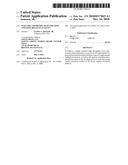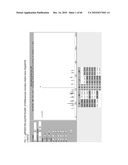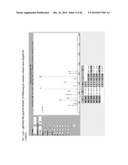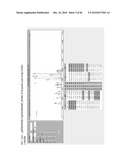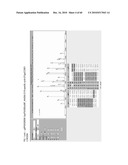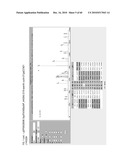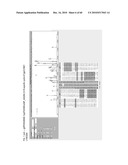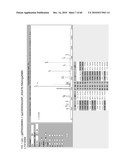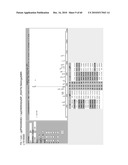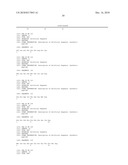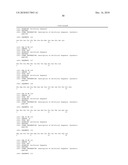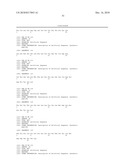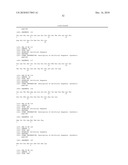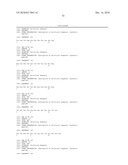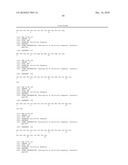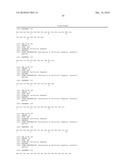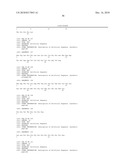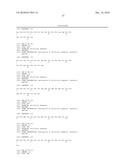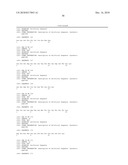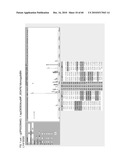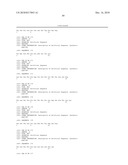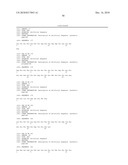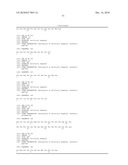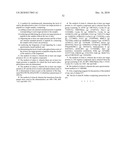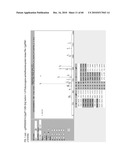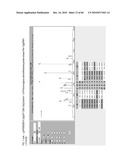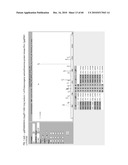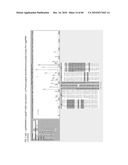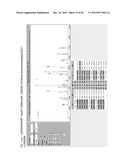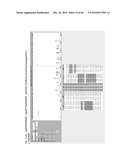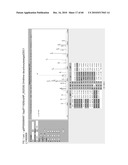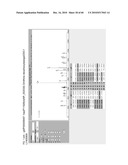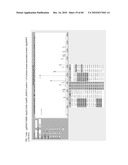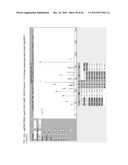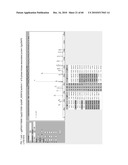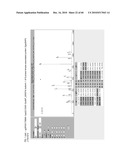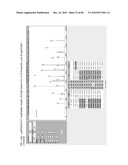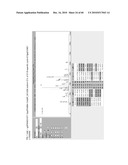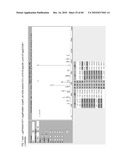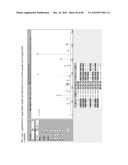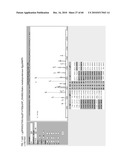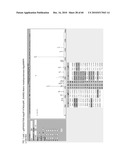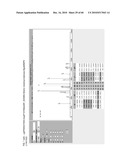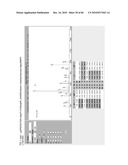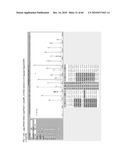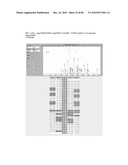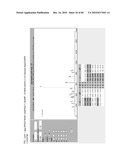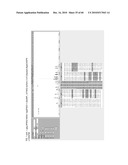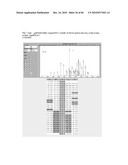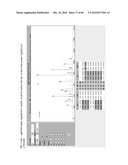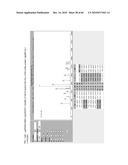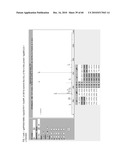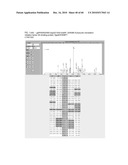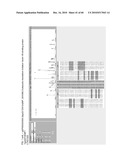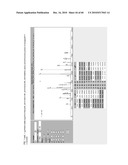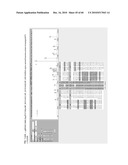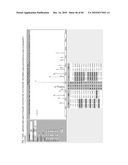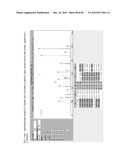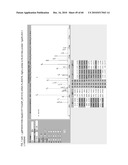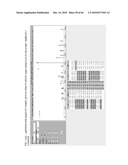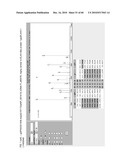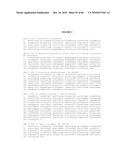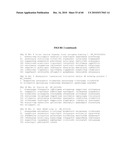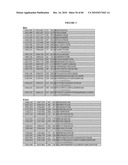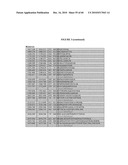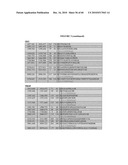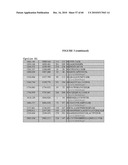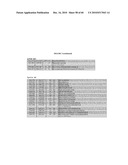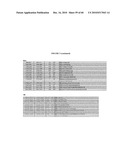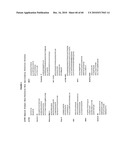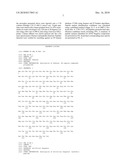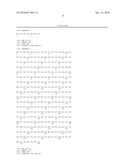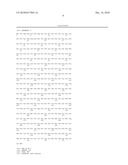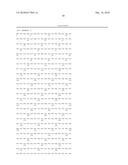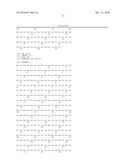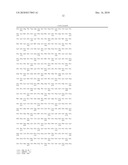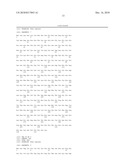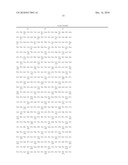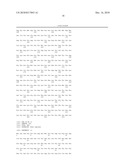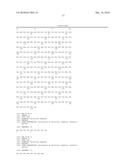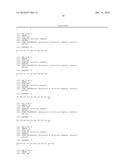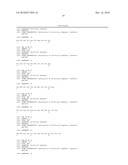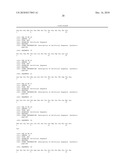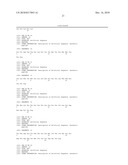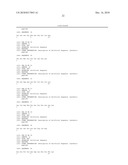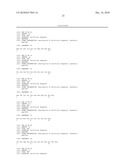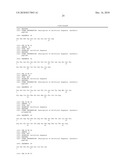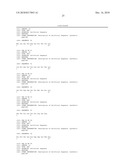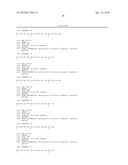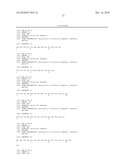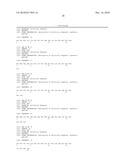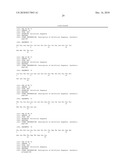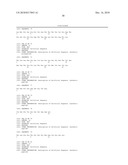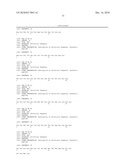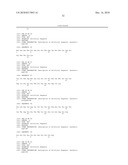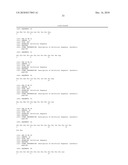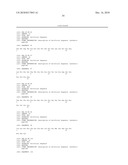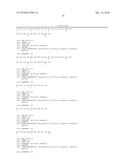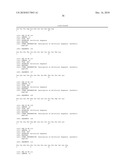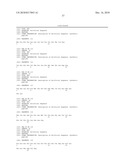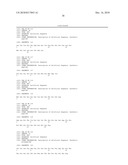Patent application title: MASS SPECTROMETRY ASSAY FOR eIF4E AND eIF4E REGULON ACTIVITY
Inventors:
Gordon A. Jamieson, Jr. (Arlington, MA, US)
IPC8 Class: AC12Q134FI
USPC Class:
435 18
Class name: Chemistry: molecular biology and microbiology measuring or testing process involving enzymes or micro-organisms; composition or test strip therefore; processes of forming such composition or test strip involving hydrolase
Publication date: 2010-12-16
Patent application number: 20100317043
Claims:
1. A method for simultaneously determining the level of and/or
phosphorylation state of at least one target protein or peptide in a
single sample, comprising:(a) adding at least one internal standard
protein or peptide corresponding to each target protein to the sample;(b)
reducing and alkylating the at least one target protein or peptide in the
sample without the use of urea;(c) digesting the at least one target
protein and the at least one internal standard protein or peptide by
contacting the sample with at least one protease;(d) analyzing the
fragments of said digesting by a mass spectrometry-based method; and(e)
determining the level of and/or phosphorylation state of the at least one
target protein or peptide using the results of the analysis of the
fragments.
2. The method of claim 1, wherein the at least one target protein is 4E or a 4E regulon component.
3. The method of claim 1, wherein there are at least two target proteins or peptides for which the level and/or phosphorylation state are determined.
4. The method of claim 1, wherein the at least one target protein is 4E and the level of and/or phosphorylation state of 4E is determined at least in part on the analysis of the fragment WALWFFK (SEQ ID NO: 2) which has a parent mass of 498 Da.
5. The method of claim 4, wherein the transitions from the parent mass used in the determination are 498->740, 498->627 and 498->371.
6. The method of claim 1, wherein the at least one target protein is a 4E regulon component and is selected from the group consisting of: eIF4E (gi: 54873625); Cyclin D1 (gi: 77628152); NBS/Nibrin (gi: 67189763); Pim-1 (gi: 31543400); Cyclin B1 (gi: 34304372); Cyclin A2 (gi: 16950653); ODC (gi: 4505488); VEGF (gi: 71051577); Skp2 (gi: 16306594, 16306593); Cyclin E1 (gi: 17318558); c-myc (gi: 71774082); FGF2 (gi: 153285460); MMP-9 (gi: 74272286); mdm2 (gi: 46488903); caspase-9 (gi: 14790123, 14790127); bcl2 (gi: 72198188, 72198345); Bcl/xL (gi: 20336334); Fbox1 (gi: 16306583); CGGbp1 (gi: 56550052); P54nrb/NONO.1 (gi: 34932413); Selenoprotein S (gi: 45439347); eIF4E-BP1 (gi: 117938308); Akt1 (gi: 62241012, 62241010, 62241014); PI3K (gi: 54792081, 212377724); GSK3B (gi: 21361339); HuR (gi: 38201713); and mTOR/FRAP1 (gi: 19924298).
7. The method of claim 1, wherein the at least one target protein is a 4E regulon component and is selected from the group consisting of: 4E, 4E-BP1, NBS/Nibrin, Pim-1, VEGF, Cyclin D1, Cyclin A2, ODC Akt and HuR.
8. The method of claim 1, wherein the mass spectrometry-based method is LC-MS/MS.
9. A kit, comprising reagents for the practice of the method of any one of claims 1-7.
10. The kit of claim 9, further comprising instructions for use.
Description:
CROSS-REFERENCE TO RELATED APPLICATIONS
[0001]This application is a continuation--in part of PCT/U.S. Ser. No. 08/082,611, filed Nov. 6, 2008, which claims priority to U.S. Provisional Patent Application No. 60/985,787, filed Nov. 6, 2007. The entire contents of each of these applications are hereby incorporated herein by reference in their entireties.
BACKGROUND
[0002]Mass spectrometry is well established as a robust assay platform for small molecules, but it is often considered only as an exploratory research tool for proteins and peptides. This is partly because of the limited throughput of mass spectrometry-based assays and the need for extensive sample processing for most target peptides and proteins especially when the concentration of the target molecule is low. If this limitation can be overcome, mass spectrometry-based assays have advantages relative to antibody-based assays. For example, synthesis of a reference peptide can be done within a few days when the amino acid sequence of the target protein is known, compared to the many months that it takes to generate an antibody against a peptide. Once the reference peptide is available, setting up mass spectrometric conditions to measure the target peptide takes less than a week. When multiple cycles of reagent generation and evaluation are involved, the difference in time to set up a mass spectrometry based assay and antibody-based assay can be even more significant. Despite these advantages, many target proteins are beyond the reach of mass spectrometry because of the need for target enrichment before analysis. The most commonly used method of target enrichment is the use of antibody, which negates the advantage of the mass spectrometry-based assay unless the desired antibodies are already available.
[0003]The eukaryotic translation initiation factor eIF4E ("4E") is involved in the modulation of cellular growth. Moderate overexpression of 4E leads to dysregulated growth and malignant transformation. Both the nuclear and cytoplasmic function of 4E contribute to its ability to transform cells. Overexpression of 4E in vivo results in frank tumor formation, and the onset of tumor formation is greatly enhanced when 4E overexpression is placed within the context of a myc mouse background, suggesting again that 4E acts in concert with other oncogenes to promote neoplastic transformation. 4E is believed to represent one of the seven genes whose expression, when up-regulated in cancers, is predictive of metastatic disease. A variety of studies have been done demonstrating that existence of elevated 4E activity within surgical margins is a poor prognosis factor.
[0004]In the nucleus, 4E is a critical node in an RNA regulon that impacts nearly every stage of cell cycle progression (Culjkovic, B., Topisirovic, I. and K. L. B. Borden (2007) Controlling gene expression through RNA regulons. Cell Cycle 6: 65-69; Culjkovic, B., Topisirovic, I., Skranbanek, L., Ruiz-Gutierrez, M., and K. L. B. Borden (2006) eIF4E is a central node of an RNA regulon thatgoverns cellular proliferation. J Cell Biol 175: 415-426; Keene, J. D. (2007) RNA regulons: Coordination of post-transcriptional events. Nature Reviews Genetics 8: 533-543). Specifically, 4E coordinately promotes the mRNA export, and in some cases also translation, of several genes involved in cell cycle progression. For example, 4E functions to promote export from the nucleus to the cytoplasm of at least two mRNAs, cyclin D1 and ornithine decarboxylase (ODC), while having no impact on the nuclear to cytoplasmic transport of GAPDH or actin mRNAs. Moreover, there is evidence that the mRNA export function of 4E is linked to its oncogenic transformation activity. Dysregulated expression of tumor suppressors and oncogenes that maintain and enhance the malignant phenotype have been described. Among these molecules are tumor suppressors like p53, Rb, and APC and oncogenes such as myc, cyclin D1 and 4E. Their interaction constitute a network of self-reinforcing feedback loops wherein inactivation of principal elements can lead to the reversal and at times even the sustained loss of the neoplastic phenotype.
[0005]4E is overexpressed in a wide variety of malignant cell lines and primary human tumors including tumors of the breast, colon, head and neck, thyroid, lung, non-Hodgkin's lymphoma, prostate, cervix, bladder and chronic and acute myelogenous leukemias. Consistently, even moderate overexpression of 4E in rodent cells leads to deregulated proliferation and malignant transformation.
[0006]Despite being essential for growth and survival of eukaryotes by acting at a critical step of cap-dependent translation and recruiting transcripts to the ribosome as a result of its specific interaction with the 5'7-methylguanosine mRNA cap structure, up-regulation of 4E does not increase translation of all cap-dependent transcripts, but only of a specific subset of 4E-sensitive transcripts.
[0007]As much as 70% of 4E is present in the nuclei of mammalian cells, where it associates with nuclear bodies in a wide variety of organism, including yeast, Xenopus and humans. Here, 4E promotes transport of mRNAs of a specific subset of transcripts such as cyclin D1, but not of housekeeping genes such as B-actin and GAPDH. Post-transcriptional regulation of gene expression at the level of 4E mediated mRNA transport and translation exhibits different gene specificities, with some gene being regulated at the level of transport (e.g. cyclin D1) and some at the level of translation (VEGF), others at both levels (ODC), and still yet others at neither level (GAPDH). Binding to the m7G cap is required both for mRNA transport and translation by 4E, both of which contribute to this ability to transform cells.
[0008]Past observation indicates that 4E's capacity to discriminate between cyclin D1 and GAPDH is surprising seeing that the traditional view is that 4E binds the m7G cap found on all mRNAs regardless of other sequence specific features. Thus, this functional discrimination presents a conundrum in terms of our understanding of 4E mRNA recognition in the nucleus.
[0009]Elevated 4E activity has been observed to mediate selectively the translation (but not transcription) of a subset of the total collection of mRNAs expressed within cells, tissues, organs. Specifically, within cells, tumors and/or cancers where 4E activity is present at elevated levels, the translation of mRNA transcripts possessing complex 5'UTR regions is selectively upregulated. The repertoire of genes whose translation is thereby upregulated in circumstances where elevated 4E activity exists is a who's who of genes known to be involved in the regulation of the cell cycle, angiogenesis, proliferation and the like. However, the molecular mechanisms that regulate 4E transport, and how regulation of 4E activity could be used to modulate such processes, is not well-characterized.
[0010]Current diagnostic, segmentation and stratification methodologies do not provide for the enhanced detection, analysis and therapeutic monitoring of 4E and 4E regulon activity.
SUMMARY
[0011]Provided are highly sensitive high throughput mass spectrometry-based quantitative assays that provide for the single sample multiplexed analysis of at least one target protein, as well as in certain embodiments the simultaneous analysis of phosphorylation states of the at least one target protein. The mass spectrometry-based assays employ an enrichment method for the target protein(s), which allows the construction of highly sensitive, high-throughput assays without the use of an antibody. The assays can be adapted to detect 4E and 4E regulon component levels and phosphorylation states, and when so adapted becomes the first single sample analytical method of the 4E/4E regulon biological pathway.
[0012]This method may be incorporated into any of a variety of methods for compositions for the identification, diagnosis and monitoring of 4E and 4E regulon component activity and for the discovery of agents that modulate 4E and 4E regulon component activity.
[0013]Kits for the practice of the methods are also described herein.
[0014]These embodiments of the present invention, other embodiments, and their features and characteristics will be apparent from the description, drawings, and claims that follow.
BRIEF DESCRIPTION OF THE DRAWINGS
[0015]FIG. 1 depicts the mass spectra obtained by an embodiment of an assay for detection of 4E and 4E regulon component levels as described in the Example below.
[0016]FIG. 2 depicts sequences of 4E regulon components that may be detected using the assays described herein.
[0017]FIG. 3 depicts potential fragments of 4E regulon components produced using trypsin digestion that may be used to analyze the 4E regulon components using the assay described herein. The columns from left to right are as follows: monoisotopic mass, average mass, starting residue, ending residue, trypic peptide sequence.
[0018]FIG. 4 presents 4E and 4E Regulon component mass-selective mass spectrometry detection analytes as provided by the Example below.
DETAILED DESCRIPTION
[0019]For convenience, certain terms employed in the specification, examples, and appended claims are collected here. Unless defined otherwise, all technical and scientific terms used herein have the same meaning as commonly understood by one of ordinary skill in the art to which this invention belongs.
[0020]The term "4E activity" or "activity of 4E" includes any of the biological effects of the 4E gene or protein, including but not limited to elevated expression of 4E, elevated protein levels of 4E, and/or activation of 4E regulon components, and phosphorylation state of 4E.
[0021]The term "4E regulon activity" or "4E regulon component activity" or "activity of a 4E regulon component" refers the activity of 4E as a mediator of the 4E regulon and also includes 4E regulon activation, expression, transport and/or activity of the 4E regulon components.
[0022]The term "4E regulon component" refers to 4E (SEQ ID NO: 1 MATVEPETTPTPNPPTTEEEKTESNQEVANPEHYIKHPLQNRWALWFFKNDKSKTW QANLRLISKFDTVEDFWALYNHIQLSSNLMPGCDYSLFKDGIEPMWEDEKNKRGGR WLITLNKQQRRSDLDRFWLETLLCLIGESFDDYSDDVCGAVVNVRAKGDKIAIWTT ECENREAVTHIGRVYKERLGLPPKIVIGYQSHADTATKSGSTTKNRFVV), any of the components of its regulon, and any modifier of the regulon such as HuR. Exemplary 4E regulon components include: eIF4E (gi: 54873625); Cyclin D1 (gi: 77628152); NBS/Nibrin (gi: 67189763); Pim-1 (gi: 31543400); Cyclin B1 (gi: 34304372); Cyclin A2 (gi: 16950653); ODC (gi: 4505488); VEGF (gi: 71051577); Skp2 (gi: 16306594, 16306593); Cyclin E1 (gi: 17318558); c-myc (gi: 71774082); FGF2 (gi: 153285460); MMP-9 (gi: 74272286); mdm2 (gi: 46488903); caspase-9 (gi: 14790123, 14790127); bcl2 (gi: 72198188, 72198345); Bcl/xL (gi: 20336334); Fbox1 (gi: 16306583); CGGbp1 (gi: 56550052); P54nrb/NONO.1 (gi: 34932413); Selenoprotein S (gi: 45439347); eIF4E-BP1 (gi: 117938308); Akt1 (gi: 62241012, 62241010, 62241014); PI3K (gi: 54792081, 212377724); GSK3B (gi: 21361339); HuR (gi: 38201713); and mTOR/FRAP1 (gi: 19924298). Preferred 4E regulon components (components) to be used in certain of the below-described methods are 4E, 4E-BP1, NBS/Nibrin, Pim-1, VEGF, Cyclin D1, Cyclin A2, ODC and HuR. A "regulon" is a family of multiple mRNAs that are coordinately regulated in a sequence specific fashion by one or more RNA binding proteins that orchestrate and control their splicing, export, stability, localization and/or translation.
[0023]The articles "a" and "an" are used herein to refer to one or to more than one (i.e., to at least one) of the grammatical object of the article. By way of example, "an component" means one component or more than one component.
[0024]As used herein, the term "amino acid" is intended to mean both naturally occurring and non-naturally occurring amino acids as well as amino acid analogs and mimetics. Naturally occurring amino acids include the 20 (L)-amino acids utilized during protein biosynthesis as well as others such as 4-hydroxyproline, hydroxylysine, desmosine, isodesmosine, homocysteine, citrulline and ornithine, for example. Non-naturally occurring amino acids include, for example, (D)-amino acids, norleucine, norvaline, p-fluorophenylalanine, ethionine and the like. Amino acid analogs include modified forms of naturally and non-naturally occurring amino acids. Such modifications can include, for example, substitution or replacement of chemical groups and moieties on the amino acid or by derivitization of the amino acid. Amino acid mimetics include, for example, organic structures which exhibit functionally similar properties such as charge and charge spacing characteristic of the reference amino acid. For example, an organic structure which mimics arginine (Arg or R) would have a positive charge moiety located in similar molecular space and having the same degree of mobility as the ε-amino group of the side chain of the naturally occurring Arg amino acid. Mimetics also include constrained structures so as to maintain optimal spacing and charge interactions of the amino acid or of the amino acid functional groups. Those skilled in the art know or can determine what structures constitute functionally equivalent amino acid analogs and amino acid mimetics.
[0025]The term "biological sample", or "sample" as used herein, refers to a sample obtained from an organism or from components (e.g., cells) of an organism. The sample may be of any biological tissue or fluid. Frequently the sample will be a "clinical sample" which is a sample derived from a patient. Such samples include, but are not limited to, sputum, blood, blood cells (e.g., white cells), tissue or fine needle biopsy samples, urine, peritoneal fluid, and pleural fluid, or cells therefrom. Biological samples may also include sections of tissues such as frozen sections taken for histological purposes.
[0026]The terms "comprise" and "comprising" are used in the inclusive, open sense, meaning that additional components may be included.
[0027]As used herein, the term "fragment" when used in reference to a polypeptide or parent polypeptide is intended to mean any truncated or smaller mass form, corresponding to either carboxyl-terminal, amino-terminal, or both regions, of a reference polypeptide or parent polypeptide. Accordingly, a deletion of a single amino acid from the carboxyl- or amino-terminus is considered a fragment of a parent polypeptide. The term fragment therefore includes deletion of amino acids at the amino- and/or carboxyl-terminus as well as modifications where, for example, an amino acid side chain is removed but the peptide bond remains. A fragment includes a truncated polypeptide that is generated, for example, by polypeptide cleavage using a chemical reagent, enzyme, or energy input. A fragment can result from a sequence-specific or sequence independent cleavage event. Examples of reagents commonly used for cleaving polypeptides include enzymes, for example, proteases, such as thrombin, trypsin, chymotrypsin and the like, and chemicals, such as cyanogen bromide, acid, base, and o-iodobenzoic acid. A fragment can also be generated by a mass spectrometry method including, for example, all types of fragmentation methods and collision induced dissociation. Furthermore, a fragment can also result from multiple cleavage events such that a truncated polypeptide resulting from one cleavage event can be further truncated by additional cleavage events.
[0028]The term "including" is used to mean "including but not limited to". "Including" and "including but not limited to" are used interchangeably.
[0029]"Protein" and "polypeptide" are used interchangeably herein when referring to a gene product, e.g., as may be encoded by a coding sequence. By "gene product" it is meant a molecule that is produced as a result of transcription of a gene. Gene products include RNA molecules transcribed from a gene, as well as proteins translated from such transcripts.
[0030]Provided, in one aspect, is a method for determining the level of and/or phosphorylation state of at least one target protein, in some embodiments simultaneously, in a single sample, comprising: (a) adding at least one internal standard protein or peptide corresponding to each target protein to the sample; (b) reducing and alkylating the at least one target protein and internal standard in the sample without the use of urea; (c) digesting the at least one target protein and the at least one internal standard protein or peptide by contacting the sample with at least one protease; (d) analyzing the fragments of said digesting by a mass spectrometry-based method; and (e) determining the level of and/or phosphorylation state of the at least one target protein using the results of the analysis of the fragments.
[0031]In certain embodiments, there are at least two, three, four, five, ten or more target proteins for which the level and/or phosphorylation state are determined. In certain embodiments the level and/or phosphorylation state of the target protein are determined simultaneously, i.e., in a multiplexed fashion.
[0032]The internal standard protein or peptide corresponds to the target protein (or a fragment of it), but includes appropriate corresponding internal marker amino acids (e.g. Leu residue with the molecular weight 7 amu higher than the natural counterpart) to modify the mass of the internal standard protein or peptide to make it distinguishable from the target protein. The protein may be modified by naturally occurring modifications such as post-translational modifications, including phosphorylation, lipidation, prenylation, sulfation, hydroxylation, acetylation, ubiquitination, glycosylation, methylation, palmitoylation, myristylation, addition of carbohydrate, addition of prosthetic groups or cofactors, formation of disulfide bonds, proteolysis, assembly into macromolecular complexes, and the like.
[0033]A modification of a protein can also include non-naturally occurring derivatives, analogues and functional mimetics thereof generated by, for example, chemical synthesis. For example, derivatives can include chemical modifications of the protein such as alkylation, acylation, carbamylation, iodination, or any modification that derivatizes the protein. Such derivatized molecules include, for example, those molecules in which free amino groups have been derivatized to form amine hydrochlorides, p-toluene sulfonyl groups, carbobenzoxy groups, t-butyloxycarbonyl groups, chloroacetyl groups or formyl groups. Free carboxyl groups can be derivatized to form salts, methyl and ethyl esters or other types of esters or hydrazides. Free hydroxyl groups can be derivatized to form O-acyl or O-alkyl derivatives. The imidazole nitrogen of histidine can be derivatized to form N-im-benzylhistidine. Also included as derivatives or analogues are those proteins which contain one or more naturally occurring amino acid derivatives of the twenty standard amino acids, for example, 4-hydroxyproline, 5-hydroxylysine, 3-methylhistidine, homoserine, ornithine or carboxyglutamate, and can include amino acids that are not linked by peptide bonds. Another specific example of a modification of a protein includes modification of proteins in a sample with a moiety having a stable isotope. For example, two different proteins can be separately labeled with moieties that are isotopically distinct, and such differentially labeled proteins can be compared. Modification of proteins with stable isotopes can be used for both quantitating the relative amount of one or more proteins in a sample.
[0034]Polypeptides can be differentially labeled by a variety of methods well known to those skilled in the art, for example, a label can be included at any position within a polypeptide for which specific chemistries or biochemical methods are available. Such positions include, for example, carboxyl and amino terminal, and amino acid side chains. A specific example of labeling carboxyl moieties, including the carboxyl terminus of a polypeptide and side chains is the esterification using methanol. Additionally cysteine can be used to attach labels through, for example, an iodoacetamide reactive group. Polypeptides in a sample can also be labeled with a moiety having a stable isotope. A moiety can be produced that is enriched or depleted in a particular stable isotope, for example, a stable isotope of an element can contain trace amounts of a different atomic weight isotope of that element which can be depleted before incorporating into the labeling moiety. Isotopic labels that can be used to label amino acids include, for example, isotopically heavy and light versions of hydrogen, carbon, oxygen, nitrogen, sulfur and selenium. The corresponding heavy isotopes of these light atoms include: 2H, 13C, 17O, 15N, 33S, 34S, and 35S.
[0035]Differentially labeled polypeptides are useful for determining the relative abundance of a polypeptide, or polypeptides, in two different samples. Changes in abundance of a particular polypeptide between two samples can indicate a role for that polypeptide in a biological process. For example, polypeptides from one sample can be labeled with a light isotope containing label while polypeptides from another sample are labeled with a heavy isotope containing label. The two different samples can be, for example, polypeptides extracted from a normal cell and a cancerous cell. A particular polypeptide species that is present in both samples will be chemically the same in the two samples except for the mass of the label or the chemistry used to attach the label. Because the differentially labeled polypeptides behave physicochemically the same, the same polypeptides in the two samples will ionize or fragment similarly, but still be distinguishable by MS due to the isotopic difference in the differential label. Accordingly, the relative amounts of the same polypeptides can be readily compared and quantitated.
[0036]Reduction and alkylation of the target proteins and internal standard proteins may be performed essentially as described earlier (Hale J E et al (2004) Anal Biochem 333:174-181) with the modifications described in the example. A key modification is that no urea should be used in this step.
[0037]The reduced and alkylated target proteins and internal standard proteins or peptides are then fragmented. Polypeptides can be fragmented by a number of methods including polypeptide cleavage using a chemical reagent, enzyme, or energy input. A fragment can result from a sequence-specific or sequence independent cleavage event. Examples of reagents commonly used for cleaving polypeptides include enzymes, for example, proteases, such as thrombin, trypsin, chymotrypsin and the like, and chemicals, such as cyanogen bromide, acid, base, and o-iodobenzoic acid. A fragment can also be generated by a mass spectrometry method including, for example, all types of fragmentation methods and collision induced dissociation (CID). Furthermore, a fragment can also result from multiple cleavage events such that a truncated polypeptide resulting from one cleavage event can be further truncated by additional cleavage events. Several identical or different fragments can be obtained from the original, or parent, polypeptide. The methods of the invention can use one or more polypeptide fragments from a population of polypeptide fragments.
[0038]Analysis of the digested fragments may be by any mass spectrometry-based method that allows high-throughput multiplexed analysis. Mass spectrometry is a sensitive and accurate technique for separating and identifying molecules. Generally, mass spectrometers have two main components, an ion source for the production of ions and a mass-selective analyzer for measuring the mass-to-charge ratio of ions, which is and converted into a measurement of mass for these ions. Several ionization methods are known in the art and described herein. Different mass spectrometry methods, for example, quadrupole mass spectrometry, ion trap mass spectrometry, time-of-flight mass spectrometry and tandem mass spectrometry can utilize various combinations of ion sources and mass analyzers which allows for flexibility in designing customized detection protocols. In addition, mass spectrometers can be programmed to transmit all ions from the ion source into the mass spectrometer either sequentially or at the same time. Furthermore, a mass spectrometer can be programmed to select ions of a particular mass for transmission into the mass spectrometer while blocking other ions. The ability to precisely control the movement of ions in a mass spectrometer allows for greater options in detection protocols which can be advantageous when a large number of fragments, for example, from a multiplex experiment, are being analyzed. Mass spectrometry methods are well known in the art (see Burlingame et al. Anal. Chem. 70:647 R-716R (1998); Kinter and Sherman, Protein Sequencing and Identification Using Tandem Mass Spectrometry Wiley-Interscience, New York (2000)). The basic processes associated with a mass spectrometry method are the generation of gas-phase ions derived from the sample, and the measurement of their mass. Mass spectrometry technology exists by which several thousands of protein species can be separated, detected and quantified in a single operation.
[0039]The mass spectrometry may be preceded by a chromatography step. New chromatography based methods for the identification of the proteins contained in complex mixtures without the need for separation of the mixture into individual protein components are available. A separation step can also be used to remove salts, enzymes, or other buffer components. Several methods well known in the art, such as chromatography, gel electrophoresis, or precipitation, can be used to clean up the sample. For example, size exclusion chromatography or affinity chromatography can be used to remove salt from a sample. The choice of separation method can depend on the amount of a sample. For example, when small amounts of sample are available or a miniturized apparutus is used, a micro-affinity chromatography separation step can be used. In addition, whether a separation step is desired, and the choice of separation method, can depend on the detection method used. For example, the efficiency of matrix-assisted laser desorption/ionization and electrospray ionization can be improved by removing salts from a sample. For example, salts can absorb energy from the laser in matrix-assisted laser desorption/ionization and result in lower ionization efficiency.
[0040]In a preferred embodiment, the method is LC-MS/MS. Currently, up to 10,000 sequencing runs can be recorded in a single LC-MS analysis of 60 minutes duration. Often the duty cycle of the mass spectrometer is the rate limiting step, however, as mass spectrometers continue to improve, the number of polypeptides that can be detected and/or sequenced in one run will continue to increase. Further automation and on-line analysis will greatly improve the efficiency of mass spectrometry. Therefore, as the instrumentation increases in efficiency the rate of polypeptides that can be detected and/or sequenced with the methods of the invention will also concurrently increase.
[0041]In certain embodiments, the above-described methods may be adapted for specifically detecting the level and/or phosphorylation state of 4E and/or at least one 4E regulon component. In one embodiment, the at least one target protein is 4E is at least in part on the analysis of the fragment SEQ ID NO: 2 WALWFFK which has a parent mass of 498 Da. The transitions from the parent mass used in the determination are 498->740, 498->627 and 498->371. In other embodiments, the at least one target protein is a 4E regulon component and is selected from the group consisting of: eIF4E (gi: 54873625); Cyclin D1 (gi: 77628152); NBS/Nibrin (gi: 67189763); Pim-1 (gi: 31543400); Cyclin B1 (gi: 34304372); Cyclin A2 (gi: 16950653); ODC (gi: 4505488); VEGF (gi: 71051577); Skp2 (gi: 16306594, 16306593); Cyclin E1 (gi: 17318558); c-myc (gi: 71774082); FGF2 (gi: 153285460); MMP-9 (gi: 74272286); mdm2 (gi: 46488903); caspase-9 (gi: 14790123, 14790127); bcl2 (gi: 72198188, 72198345); Bcl/xL (gi: 20336334); Fbox1 (gi: 16306583); CGGbp1 (gi: 56550052); P54nrb/NONO.1 (gi: 34932413); Selenoprotein S (gi: 45439347); eIF4E-BP1 (gi: 117938308); Akt1 (gi: 62241012, 62241010, 62241014); PI3K (gi: 54792081, 212377724); GSK3B (gi: 21361339); HuR (gi: 38201713); and mTOR/FRAP1 (gi: 19924298). Preferred 4E regulon components (components) to be used in certain of the below-described methods are 4E, 4E-BP1, NBS/Nibrin, Pim-1, VEGF, Cyclin D1, Cyclin A2, ODC and HuR. Preferred regulon components include 4E regulon component and is selected from the group consisting of: 4E, 4E-BP1, NBS/Nibrin, Pim-1, VEGF, Cyclin D1, Cyclin A2, ODC, Akt and HuR.
[0042]The assays for detecting the level and/or phosphorylation state of 4E and/or at least one 4E regulon component described above may be incorporated into any of a variety of methods for compositions for the identification, diagnosis and monitoring of 4E and 4E regulon component activity and for the discovery of agents that modulate 4E and 4E regulon component activity. Such methods are described extensively in PCT Application US06/049450, filed Dec. 28, 2006 and PCT Application U.S. 07/021,167 filed Oct. 1, 2007, both of which applications are hereby incorporated by reference in their entireties.
[0043]In certain embodiments, the level of and/or phosphorylation state of 4E or a 4E regulon component may be compared to the level of and/or phosphorylation state of a control, such as actin or GADPH.
[0044]The present invention provides kits for practice of any of the aforedescribed methods. In certain embodiments, kits may comprise internal protein standards and reagents for creating fragments of the standards and target proteins. A kit may further comprise controls, buffers, and instructions for use. Kit components may be packaged for either manual or partially or wholly automated practice of the foregoing methods. Such kits may have a variety of uses, including, for example, imaging, diagnosis, therapy, and other applications.
Example
[0045]The present invention is further illustrated by the following example which should not be construed as limiting in any way. The contents of all cited references including literature references, issued patents, published or non published patent applications as cited throughout this application are hereby expressly incorporated by reference.
[0046]A highly sensitive high throughput mass spectrometry-based quantitative assay for 4E and 4E regulon components has been developed which provides for the single sample multiplexed analysis of 4E and 4E regulon component levels, as well as the potential simultaneous analysis of 4E and 4E regulon component phosphorylation states, providing for the first single sample analysis of the 4E/4E regulon biological pathway.
[0047]The mass spectrometry-based assay employs an enrichment method for the target protein(s), which allows the construction of a highly sensitive, high-throughput assay without the use of an antibody. The enrichment step was built into the reduction/alkylation step so that the enrichment method did not introduce any extra steps or reagents to sample preparation. A similar approach may be applicable to development of mass spectrometry-based assay for many other proteins. Other types of non-antibody based enrichment methods have been successfully adopted to develop mass spectrometry-based assay for a variety of different proteins. The throughput of the assay was comparable to or higher than most antibody-based assays. For example, one person processed more than a thousand samples in a week in duplicate without use of a robotic system.
[0048]Reagents: Trypsin-gold was purchased from Promega (Cat # V5280). Ammonium carbonate, ammonium bicarbonate, 2-iodoethanol, and triethylphosphine were from Sigma. Mass-spectrometry grade formic acid was from Sigma. Water with 0.1% formic acid was from Fisher Scientific. Acetonitrile (CAN) was from Burdick & Jackson. Synthetic peptides were from Midwest Biotech (Fishers, Ind.).
[0049]Sample preparation: Proteins were digested with trypsin before analysis by tandem mass spectrometry coupled in line with high performance liquid chromatography (LC-MS/MS). When target peptide(s) contain a Cys residue, serum/plasma proteins were first reduced and alkylated prior to trypsin digestion. Reduction and alkylation of the serum or plasma proteins was done in one step essentially as described earlier (Hale J E et al (2004) Anal Biochem 333:174-181) with the following modifications. Most importantly, urea was omitted during the coupled reduction/alkylation step. Typically, 10 μL of serum or plasma sample was diluted with 50 μL of ammonium carbonate solution (0.1 M, pH 11) in a polypropylene container and kept on ice followed by mixing with 80 uL of reduction/alkylation cocktail (R/A cocktail) at room temperature. The R/A cocktail was prepared by mixing 0.5 mL 2-iodoethanol, 0.125 mL triethylphosphine, and 24.375 mL of acetonitrile (2-Iodoethanol comes with copper granules as a stabilizer and was filtered through 0.45 μm spin filter (Millipore UFC30HV00) immediately prior to preparation of the R/A cocktail). For smaller volume of samples, total volume was maintained the same by prediluting the serum with phosphate buffered saline (PBS). For larger volume of samples, each reagent volume was increased accordingly. After adding the R/A cocktail to the diluted sample in alkaline pH, the samples were mixed thoroughly and incubated for 1 h at 37° C. with constant shaking Reduced and alkylated samples were centrifuged at 4000 rpm for 4 min then filtered through SolvInert filter plates (Millipore, MSRLN0450) to remove precipitated proteins. Solvents as well as the remaining reduction/alkylation reagents were removed from the filtrate by SpeedVac (miVac DUO concentrator from GeneVac Cat # DUC-12060-000) typically under high heat (75° C.) for 6 h followed by an additional 12-18 h at room temperature. Dried samples were dissolved in 100 μL of 100 mM ammonium bicarbonate solution (ABC) containing trypsin (1 μg of Trypsin-gold per 10 μL initial plasma or serum volume). The best results were obtained when samples were reconstituted with Trypsin-gold immediately after removal from the SpeedVac. Plates were sealed using pierceable heat-sealing aluminum foil (ABgene Cat # AB-0757) using a heat sealer (Eppendorf, Cat # 5390) and incubated with trypsin for 6 h to overnight then filtered through SolvInert filter plates (Millipore, MSRLN0450) before injecting 50 μL to the LC-MS/MS system.
[0050]Optimization of the Sample Preparation Procedure for High-Throughput Handling:
[0051]Reduction/alkylation reaction was performed in 96-well PCR plates with a tall raised-rim around individual wells (Robbins, Surrey UK, Cat # 1055-00-0). A precursor of an internal standard peptide includes appropriate corresponding internal marker amino acids (e.g. Leu residue with the molecular weight 7 amu higher than the natural counterpart) was prepared in ice-cold ammonium carbonate buffer at 50 nM concentration. Fifty microliter of this solution was dispensed into the PCR plates using a Multiprop (Thermo). The PCR plates were kept chilled on ice while 10 μL of serum or plasma samples were transferred and mixed in duplicate. The R/A cocktail was added at room temperature using an eight-channel multidispense pipet. Prerinsing of the pipet tips was important for accurate delivery of the reagent due to high vapor pressure of the acetonitrile in the solution. Plates were sealed using pierceable heat-sealing aluminum foil (ABgene Cat # AB-0757) using a heat sealer (Eppendorf, Cat # 5390) then mixed thoroughly. Plates were incubated at 37° C. for 1 h with moderate shaking Plates were centrifuged for 4 min at 4000 rpm before peeling the sealing foil. The filtration assembly was prepared by putting a SolvInert filter plate from Millipore (MSRLN0450) on top of the tall raised-rim PCR plate (TempPlate II from USA Scientific, Cat # 1402-9600) as a receiving plate in a locking position. The outlet of this filter plate fits into the raised rim of the receiving plate. The filtration assembly was placed over the sample plate in an upside-down position to form a filtration sandwich so that the raised rim of the sample plate is inserted into individual well of the filter plate. The filtration sandwich was inverted and centrifuged for 1 min at 1000 rpm followed by 4 min at 4000 rpm. The filtrates were dried by SpeedVac as described above and then samples were reconstituted with Trypsin gold, the plates sealed and samples digested at 37° C. overnight. Because the sample preparation method involves two filtration steps, the final sample plate is in the same orientation as the initial reduction/alkylation plate. Enrichment procedures as described above or as suitable for the target protein/peptides are employed as required.
[0052]LC-MS/MS of 4E and 4E regulon component peptides: Tryptic peptide derived from 4E and individual 4E regulon components are measured and detected using in-line LC-MS/MS for quantitation of 4E and eIF4E regulon components. In the corresponding standard peptide, the Leu residue (or appropriate internal standard heavy labeled amino acid residue) is uniformly labeled with N15 and C13. Interfering peptides were separated by an HPLC system (Surveyor MS pump from Thermo Finnigan) on a C18 reversed-phase column (XBridge 2.5 um×2.1 mm×50 mm) using the following two-solvent gradient system as required (solvent A, 0.1% formic acid/H2O; solvent B, 0.1% formic acid/acetonitrile). The HPLC column was maintained at 50° C., and the solvents were kept at room temperature and the samples were kept at 4° C. Typically 50 μL of the sample out of total volume of 100 μL was injected using a sample injection loop of 100 μL and peptides was eluted at the times indicated. Two water blank samples were injected before the actual samples so that the HPLC column could reach a steady state. Typical carry-over of pNTTP peptide from previous run was less than 0.1%.
[0053]Positive ion mass spectrometry was obtained using an LTQ ion trap quadrupole mass spectrometer equipped with an ESI source (Thermo Finnigan). The entire effluent of the column was directed to the ESI source between 2 and 3 min of HPLC run, whereas the rest was diverted away from the mass spectrometer. To accommodate high flow rate, certain parameters for the instrument had to be adjusted manually including transfer capillary temperature (312° C.) and nitrogen sheath flow.
[0054]All microscans were set to one microscan of 50 ms collection of ions for the trap. In the instrument method, the following parameters were used for MS-MS conditions; normalized collision energy, 21; activation Q, 0.180; activation time, 50 ms. Three MS-MS transitions were measured for both the standard peptide and target 4E and 4e regulon peptides.
[0055]Peak Integration and Curve Fitting: Peak integration was done using a processing method within XCaliber software using the following parameters: peak integration method, ICIS; smoothing points, 5; baseline window, 15; area noise factor, 1; peak noise factor, 3 for the standard peptide and 5 for target 4E and 4E regulon peptides; constrain peak width, 5% peak height and 3% tailing factor; advanced option, repetitive noise method. Isotopic distribution and relative intensities among three transitions for each peptide was examined and was confirmed to match with those of synthetic peptides. The ratio between the standard peptide and 4E and 4E regulon target peptides were calculated for each transition then numeric average of the three ratios was obtained. NPI values for the calibration standard samples were fitted to a sigmoidal curve (NPI) Bottom+(Top-Bottom)/(1+10 ((log EC50-X)*(Hill Slope))) where X is the logarithm of concentration; Bottom, Top, EC50, and Hill Slope are parameters to be determined by the curve fitting of the data) using a nonlinear curve fitting function of the GraphPad Prism (GraphPad Software, Inc., San Diego, Calif.) with 1/Y 2 as a weighting factor. It was important to use the weighting factor to obtain calibration curve that works over the entire concentration range equally well.
[0056]Embodiment of Assay for Detection of 4E Levels and Phosphorylation States: The peptide used to detect 4E was SEQ ID NO: 2: WALWFFK. Its parent mass is 498 and the transitions used were 498->740, 498->627 and 498->371.
[0057]The mass spectra determined as described above are shown in FIG. 1.
[0058]Other peptides such as those in FIGS. 2 and 3 may be used in the aforedescribed assay to detect the 4E regulon components from which they are derived
[0059]Embodiment of Assay for Detection of 4E Regulon Component Levels and Phosphorylation States The sequences of 4E regulon components that may be detected using the above-described assay are shown in FIG. 2. Potential digestion product peptides used to analyze each of the components are shown in FIG. 3.
[0060]eIF4E Regulon Component Analyte Determination by Mass-Selective Mass Spectrometry: Purified proteins were obtained from a commercial supplier (Origene) and prepared for mass-selective mass-spectrometry using the following procedure. Samples were precipitated with acetone, denatured in 8M urea, reduced with 10 mM DTT in 10 mM ammonium bicarbonate and alkylated with 55 mM iodoacetamide in ammonium bicarbonate. Each sample was then treated with Trypsin (Promega) and incubated overnight at 37 degrees Celsius. The tryptic peptides mixtures obtained using the procedure presented above were injected onto a C18 column (Xbridge C18 2.5 uM-2.1 mm×5 cm). Tryptic peptides were eluted with a linear gradient from 3 to 45% acetonitrile (in water) developed over 120 min at 50 degrees Celsius using a flow rate of 200 uL/min using a Surveyor HPLC pump. Column effluent was electro-sprayed into the LTQ mass spectrometer (Thermo) and peptides detected. Peptides detected were verified by searching against an IPI human database (V360) using Sequest and X!Tandem algorithms. Peptide analyte identification confidence was calculated using a published method (Higgs, R. E. et al (2007) J Proteome Res. 4: 1758-1767). All peptides presented had identification confidence levels exceeding 99%. A summary of peptide analytes identified for eIF4E Regulon components are presented in FIG. 4 and their corresponding mass spectra are presented in FIG. 1.
Sequence CWU
1
1861217PRTUnknownDescription of Unknown 4E regulon component
polypeptide 1Met Ala Thr Val Glu Pro Glu Thr Thr Pro Thr Pro Asn Pro Pro
Thr1 5 10 15Thr Glu Glu
Glu Lys Thr Glu Ser Asn Gln Glu Val Ala Asn Pro Glu 20
25 30His Tyr Ile Lys His Pro Leu Gln Asn Arg
Trp Ala Leu Trp Phe Phe 35 40
45Lys Asn Asp Lys Ser Lys Thr Trp Gln Ala Asn Leu Arg Leu Ile Ser 50
55 60Lys Phe Asp Thr Val Glu Asp Phe Trp
Ala Leu Tyr Asn His Ile Gln65 70 75
80Leu Ser Ser Asn Leu Met Pro Gly Cys Asp Tyr Ser Leu Phe
Lys Asp 85 90 95Gly Ile
Glu Pro Met Trp Glu Asp Glu Lys Asn Lys Arg Gly Gly Arg 100
105 110Trp Leu Ile Thr Leu Asn Lys Gln Gln
Arg Arg Ser Asp Leu Asp Arg 115 120
125Phe Trp Leu Glu Thr Leu Leu Cys Leu Ile Gly Glu Ser Phe Asp Asp
130 135 140Tyr Ser Asp Asp Val Cys Gly
Ala Val Val Asn Val Arg Ala Lys Gly145 150
155 160Asp Lys Ile Ala Ile Trp Thr Thr Glu Cys Glu Asn
Arg Glu Ala Val 165 170
175Thr His Ile Gly Arg Val Tyr Lys Glu Arg Leu Gly Leu Pro Pro Lys
180 185 190Ile Val Ile Gly Tyr Gln
Ser His Ala Asp Thr Ala Thr Lys Ser Gly 195 200
205Ser Thr Thr Lys Asn Arg Phe Val Val 210
21527PRTArtificial SequenceDescription of Artificial Sequence Synthetic
peptide 2Trp Ala Leu Trp Phe Phe Lys1 53295PRTHomo
sapiens 3Met Glu His Gln Leu Leu Cys Cys Glu Val Glu Thr Ile Arg Arg Ala1
5 10 15Tyr Pro Asp Ala
Asn Leu Leu Asn Asp Arg Val Leu Arg Ala Met Leu 20
25 30Lys Ala Glu Glu Thr Cys Ala Pro Ser Val Ser
Tyr Phe Lys Cys Val 35 40 45Gln
Lys Glu Val Leu Pro Ser Met Arg Lys Ile Val Ala Thr Trp Met 50
55 60Leu Glu Val Cys Glu Glu Gln Lys Cys Glu
Glu Glu Val Phe Pro Leu65 70 75
80Ala Met Asn Tyr Leu Asp Arg Phe Leu Ser Leu Glu Pro Val Lys
Lys 85 90 95Ser Arg Leu
Gln Leu Leu Gly Ala Thr Cys Met Phe Val Ala Ser Lys 100
105 110Met Lys Glu Thr Ile Pro Leu Thr Ala Glu
Lys Leu Cys Ile Tyr Thr 115 120
125Asp Asn Ser Ile Arg Pro Glu Glu Leu Leu Gln Met Glu Leu Leu Leu 130
135 140Val Asn Lys Leu Lys Trp Asn Leu
Ala Ala Met Thr Pro His Asp Phe145 150
155 160Ile Glu His Phe Leu Ser Lys Met Pro Glu Ala Glu
Glu Asn Lys Gln 165 170
175Ile Ile Arg Lys His Ala Gln Thr Phe Val Ala Leu Cys Ala Thr Asp
180 185 190Val Lys Phe Ile Ser Asn
Pro Pro Ser Met Val Ala Ala Gly Ser Val 195 200
205Val Ala Ala Val Gln Gly Leu Asn Leu Arg Ser Pro Asn Asn
Phe Leu 210 215 220Ser Tyr Tyr Arg Leu
Thr Arg Phe Leu Ser Arg Val Ile Lys Cys Asp225 230
235 240Pro Asp Cys Leu Arg Ala Cys Gln Glu Gln
Ile Glu Ala Leu Leu Glu 245 250
255Ser Ser Leu Arg Gln Ala Gln Gln Asn Met Asp Pro Lys Ala Ala Glu
260 265 270Glu Glu Glu Glu Glu
Glu Glu Glu Val Asp Leu Ala Cys Thr Pro Thr 275
280 285Asp Val Arg Asp Val Asp Ile 290
2954354PRTHomo sapiens 4Met Thr Asp Arg Gln Thr Asp Thr Ala Pro Ser Pro
Ser Tyr His Leu1 5 10
15Leu Pro Gly Arg Arg Arg Thr Val Asp Ala Ala Ala Ser Arg Gly Gln
20 25 30Gly Pro Glu Pro Ala Pro Gly
Gly Gly Val Glu Gly Val Gly Ala Arg 35 40
45Gly Val Ala Leu Lys Leu Phe Val Gln Leu Leu Gly Cys Ser Arg
Phe 50 55 60Gly Gly Ala Val Val Arg
Ala Gly Glu Ala Glu Pro Ser Gly Ala Ala65 70
75 80Arg Ser Ala Ser Ser Gly Arg Glu Glu Pro Gln
Pro Glu Glu Gly Glu 85 90
95Glu Glu Glu Glu Lys Glu Glu Glu Arg Gly Pro Gln Trp Arg Leu Gly
100 105 110Ala Arg Lys Pro Gly Ser
Trp Thr Gly Glu Ala Ala Val Cys Ala Asp 115 120
125Ser Ala Pro Ala Ala Arg Ala Pro Gln Ala Leu Ala Arg Ala
Ser Gly 130 135 140Arg Gly Gly Arg Val
Ala Arg Arg Gly Ala Glu Glu Ser Gly Pro Pro145 150
155 160His Ser Pro Ser Arg Arg Gly Ser Ala Ser
Arg Ala Gly Pro Gly Arg 165 170
175Ala Ser Glu Thr Met Asn Phe Leu Leu Ser Trp Val His Trp Ser Leu
180 185 190Ala Leu Leu Leu Tyr
Leu His His Ala Lys Trp Ser Gln Ala Ala Pro 195
200 205Met Ala Glu Gly Gly Gly Gln Asn His His Glu Val
Val Lys Phe Met 210 215 220Asp Val Tyr
Gln Arg Ser Tyr Cys His Pro Ile Glu Thr Leu Val Asp225
230 235 240Ile Phe Gln Glu Tyr Pro Asp
Glu Ile Glu Tyr Ile Phe Lys Pro Ser 245
250 255Cys Val Pro Leu Met Arg Cys Gly Gly Cys Cys Asn
Asp Glu Gly Leu 260 265 270Glu
Cys Val Pro Thr Glu Glu Ser Asn Ile Thr Met Gln Ile Met Arg 275
280 285Ile Lys Pro His Gln Gly Gln His Ile
Gly Glu Met Ser Phe Leu Gln 290 295
300His Asn Lys Cys Glu Cys Arg Pro Lys Lys Asp Arg Ala Arg Gln Glu305
310 315 320Asn Pro Cys Gly
Pro Cys Ser Glu Arg Arg Lys His Leu Phe Val Gln 325
330 335Asp Pro Gln Thr Cys Lys Cys Ser Cys Lys
Asn Thr Asp Ser Arg Cys 340 345
350Lys Met 5461PRTHomo sapiens 5Met Asn Asn Phe Gly Asn Glu Glu Phe Asp
Cys His Phe Leu Asp Glu1 5 10
15Gly Phe Thr Ala Lys Asp Ile Leu Asp Gln Lys Ile Asn Glu Val Ser
20 25 30Ser Ser Asp Asp Lys Asp
Ala Phe Tyr Val Ala Asp Leu Gly Asp Ile 35 40
45Leu Lys Lys His Leu Arg Trp Leu Lys Ala Leu Pro Arg Val
Thr Pro 50 55 60Phe Tyr Ala Val Lys
Cys Asn Asp Ser Lys Ala Ile Val Lys Thr Leu65 70
75 80Ala Ala Thr Gly Thr Gly Phe Asp Cys Ala
Ser Lys Thr Glu Ile Gln 85 90
95Leu Val Gln Ser Leu Gly Val Pro Pro Glu Arg Ile Ile Tyr Ala Asn
100 105 110Pro Cys Lys Gln Val
Ser Gln Ile Lys Tyr Ala Ala Asn Asn Gly Val 115
120 125Gln Met Met Thr Phe Asp Ser Glu Val Glu Leu Met
Lys Val Ala Arg 130 135 140Ala His Pro
Lys Ala Lys Leu Val Leu Arg Ile Ala Thr Asp Asp Ser145
150 155 160Lys Ala Val Cys Arg Leu Ser
Val Lys Phe Gly Ala Thr Leu Arg Thr 165
170 175Ser Arg Leu Leu Leu Glu Arg Ala Lys Glu Leu Asn
Ile Asp Val Val 180 185 190Gly
Val Ser Phe His Val Gly Ser Gly Cys Thr Asp Pro Glu Thr Phe 195
200 205Val Gln Ala Ile Ser Asp Ala Arg Cys
Val Phe Asp Met Gly Ala Glu 210 215
220Val Gly Phe Ser Met Tyr Leu Leu Asp Ile Gly Gly Gly Phe Pro Gly225
230 235 240Ser Glu Asp Val
Lys Leu Lys Phe Glu Glu Ile Thr Gly Val Ile Asn 245
250 255Pro Ala Leu Asp Lys Tyr Phe Pro Ser Asp
Ser Gly Val Arg Ile Ile 260 265
270Ala Glu Pro Gly Arg Tyr Tyr Val Ala Ser Ala Phe Thr Leu Ala Val
275 280 285Asn Ile Ile Ala Lys Lys Ile
Val Leu Lys Glu Gln Thr Gly Ser Asp 290 295
300Asp Glu Asp Glu Ser Ser Glu Gln Thr Phe Met Tyr Tyr Val Asn
Asp305 310 315 320Gly Val
Tyr Gly Ser Phe Asn Cys Ile Leu Tyr Asp His Ala His Val
325 330 335Lys Pro Leu Leu Gln Lys Arg
Pro Lys Pro Asp Glu Lys Tyr Tyr Ser 340 345
350Ser Ser Ile Trp Gly Pro Thr Cys Asp Gly Leu Asp Arg Ile
Val Glu 355 360 365Arg Cys Asp Leu
Pro Glu Met His Val Gly Asp Trp Met Leu Phe Glu 370
375 380Asn Met Gly Ala Tyr Thr Val Ala Ala Ala Ser Thr
Phe Asn Gly Phe385 390 395
400Gln Arg Pro Thr Ile Tyr Tyr Val Met Ser Gly Pro Ala Trp Gln Leu
405 410 415Met Gln Gln Phe Gln
Asn Pro Asp Phe Pro Pro Glu Val Glu Glu Gln 420
425 430Asp Ala Ser Thr Leu Pro Val Ser Cys Ala Trp Glu
Ser Gly Met Lys 435 440 445Arg His
Arg Ala Ala Cys Ala Ser Ala Ser Ile Asn Val 450 455
4606672PRTHomo sapiens 6Met Gln Asn Gly Phe Ser Arg Thr Leu
Lys Ser Gly Asp Gly Ile Thr1 5 10
15Phe Gly Val Phe Gly Ser Lys Phe Arg Ile Glu Tyr Glu Pro Leu
Val 20 25 30Ala Cys Ser Ser
Cys Leu Asp Val Ser Gly Lys Thr Ala Leu Asn Gln 35
40 45Ala Ile Leu Gln Leu Gly Gly Phe Thr Val Asn Asn
Trp Thr Glu Glu 50 55 60Cys Thr His
Leu Val Met Val Ser Val Lys Val Thr Ile Lys Thr Ile65 70
75 80Cys Ala Leu Ile Cys Gly Arg Pro
Ile Val Lys Pro Glu Tyr Phe Thr 85 90
95Glu Phe Leu Lys Ala Val Glu Ser Lys Lys Gln Pro Pro Gln
Ile Glu 100 105 110Ser Phe Tyr
Pro Pro Leu Asp Glu Pro Ser Ile Gly Ser Lys Asn Val 115
120 125Asp Leu Ser Gly Arg Gln Glu Arg Lys Gln Ile
Phe Lys Gly Lys Thr 130 135 140Phe Ile
Phe Leu Asn Ala Lys Gln His Lys Lys Leu Ser Ser Ala Val145
150 155 160Val Phe Gly Gly Gly Glu Ala
Arg Leu Ile Thr Glu Glu Asn Glu Glu 165
170 175Glu His Asn Phe Phe Leu Ala Pro Gly Thr Cys Val
Val Asp Thr Gly 180 185 190Ile
Thr Asn Ser Gln Thr Leu Ile Pro Asp Cys Gln Lys Lys Trp Ile 195
200 205Gln Ser Ile Met Asp Met Leu Gln Arg
Gln Gly Leu Arg Pro Ile Pro 210 215
220Glu Ala Glu Ile Gly Leu Ala Val Ile Phe Met Thr Thr Lys Asn Tyr225
230 235 240Cys Asp Pro Gln
Gly His Pro Ser Thr Gly Leu Lys Thr Thr Thr Pro 245
250 255Gly Pro Ser Leu Ser Gln Gly Val Ser Val
Asp Glu Lys Leu Met Pro 260 265
270Ser Ala Pro Val Asn Thr Thr Thr Tyr Val Ala Asp Thr Glu Ser Glu
275 280 285Gln Ala Asp Thr Trp Asp Leu
Ser Glu Arg Pro Lys Glu Ile Lys Val 290 295
300Ser Lys Met Glu Gln Lys Phe Arg Met Leu Ser Gln Asp Ala Pro
Thr305 310 315 320Val Lys
Glu Ser Cys Lys Thr Ser Ser Asn Asn Asn Ser Met Val Ser
325 330 335Asn Thr Leu Ala Lys Met Arg
Ile Pro Asn Tyr Gln Leu Ser Pro Thr 340 345
350Lys Leu Pro Ser Ile Asn Lys Ser Lys Asp Arg Ala Ser Gln
Gln Gln 355 360 365Gln Thr Asn Ser
Ile Arg Asn Tyr Phe Gln Pro Ser Thr Lys Lys Arg 370
375 380Glu Arg Asp Glu Glu Asn Gln Glu Met Ser Ser Cys
Lys Ser Ala Arg385 390 395
400Ile Glu Thr Ser Cys Ser Leu Leu Glu Gln Thr Gln Pro Ala Thr Pro
405 410 415Ser Leu Trp Lys Asn
Lys Glu Gln His Leu Ser Glu Asn Glu Pro Val 420
425 430Asp Thr Asn Ser Asp Asn Asn Leu Phe Thr Asp Thr
Asp Leu Lys Ser 435 440 445Ile Val
Lys Asn Ser Ala Ser Lys Ser His Ala Ala Glu Lys Leu Arg 450
455 460Ser Asn Lys Lys Arg Glu Met Asp Asp Val Ala
Ile Glu Asp Glu Val465 470 475
480Leu Glu Gln Leu Phe Lys Asp Thr Lys Pro Glu Leu Glu Ile Asp Val
485 490 495Lys Val Gln Lys
Gln Glu Glu Asp Val Asn Val Arg Lys Arg Pro Arg 500
505 510Met Asp Ile Glu Thr Asn Asp Thr Phe Ser Asp
Glu Ala Val Pro Glu 515 520 525Ser
Ser Lys Ile Ser Gln Glu Asn Glu Ile Gly Lys Lys Arg Glu Leu 530
535 540Lys Glu Asp Ser Leu Trp Ser Ala Lys Glu
Ile Ser Asn Asn Asp Lys545 550 555
560Leu Gln Asp Asp Ser Glu Met Leu Pro Lys Lys Leu Leu Leu Thr
Glu 565 570 575Phe Arg Ser
Leu Val Ile Lys Asn Ser Thr Ser Arg Asn Pro Ser Gly 580
585 590Ile Asn Asp Asp Tyr Gly Gln Leu Lys Asn
Phe Lys Lys Phe Lys Lys 595 600
605Val Thr Tyr Pro Gly Ala Gly Lys Leu Pro His Ile Ile Gly Gly Ser 610
615 620Asp Leu Ile Ala His His Ala Arg
Lys Asn Thr Glu Leu Glu Glu Trp625 630
635 640Leu Arg Gln Glu Met Glu Val Gln Asn Gln His Ala
Lys Glu Glu Ser 645 650
655Leu Ala Asp Asp Leu Phe Arg Tyr Asn Pro Tyr Leu Lys Arg Arg Arg
660 665 6707313PRTHomo sapiens 7Met
Leu Leu Ser Lys Ile Asn Ser Leu Ala His Leu Arg Ala Ala Pro1
5 10 15Cys Asn Asp Leu His Ala Thr
Lys Leu Ala Pro Gly Lys Glu Lys Glu 20 25
30Pro Leu Glu Ser Gln Tyr Gln Val Gly Pro Leu Leu Gly Ser
Gly Gly 35 40 45Phe Gly Ser Val
Tyr Ser Gly Ile Arg Val Ser Asp Asn Leu Pro Val 50 55
60Ala Ile Lys His Val Glu Lys Asp Arg Ile Ser Asp Trp
Gly Glu Leu65 70 75
80Pro Asn Gly Thr Arg Val Pro Met Glu Val Val Leu Leu Lys Lys Val
85 90 95Ser Ser Gly Phe Ser Gly
Val Ile Arg Leu Leu Asp Trp Phe Glu Arg 100
105 110Pro Asp Ser Phe Val Leu Ile Leu Glu Arg Pro Glu
Pro Val Gln Asp 115 120 125Leu Phe
Asp Phe Ile Thr Glu Arg Gly Ala Leu Gln Glu Glu Leu Ala 130
135 140Arg Ser Phe Phe Trp Gln Val Leu Glu Ala Val
Arg His Cys His Asn145 150 155
160Cys Gly Val Leu His Arg Asp Ile Lys Asp Glu Asn Ile Leu Ile Asp
165 170 175Leu Asn Arg Gly
Glu Leu Lys Leu Ile Asp Phe Gly Ser Gly Ala Leu 180
185 190Leu Lys Asp Thr Val Tyr Thr Asp Phe Asp Gly
Thr Arg Val Tyr Ser 195 200 205Pro
Pro Glu Trp Ile Arg Tyr His Arg Tyr His Gly Arg Ser Ala Ala 210
215 220Val Trp Ser Leu Gly Ile Leu Leu Tyr Asp
Met Val Cys Gly Asp Ile225 230 235
240Pro Phe Glu His Asp Glu Glu Ile Ile Arg Gly Gln Val Phe Phe
Arg 245 250 255Gln Arg Val
Ser Ser Glu Cys Gln His Leu Ile Arg Trp Cys Leu Ala 260
265 270Leu Arg Pro Ser Asp Arg Pro Thr Phe Glu
Glu Ile Gln Asn His Pro 275 280
285Trp Met Gln Asp Val Leu Leu Pro Gln Glu Thr Ala Glu Ile His Leu 290
295 300His Ser Leu Ser Pro Gly Pro Ser
Lys305 3108480PRTHomo sapiens 8Met Ser Asp Val Ala Ile
Val Lys Glu Gly Trp Leu His Lys Arg Gly1 5
10 15Glu Tyr Ile Lys Thr Trp Arg Pro Arg Tyr Phe Leu
Leu Lys Asn Asp 20 25 30Gly
Thr Phe Ile Gly Tyr Lys Glu Arg Pro Gln Asp Val Asp Gln Arg 35
40 45Glu Ala Pro Leu Asn Asn Phe Ser Val
Ala Gln Cys Gln Leu Met Lys 50 55
60Thr Glu Arg Pro Arg Pro Asn Thr Phe Ile Ile Arg Cys Leu Gln Trp65
70 75 80Thr Thr Val Ile Glu
Arg Thr Phe His Val Glu Thr Pro Glu Glu Arg 85
90 95Glu Glu Trp Thr Thr Ala Ile Gln Thr Val Ala
Asp Gly Leu Lys Lys 100 105
110Gln Glu Glu Glu Glu Met Asp Phe Arg Ser Gly Ser Pro Ser Asp Asn
115 120 125Ser Gly Ala Glu Glu Met Glu
Val Ser Leu Ala Lys Pro Lys His Arg 130 135
140Val Thr Met Asn Glu Phe Glu Tyr Leu Lys Leu Leu Gly Lys Gly
Thr145 150 155 160Phe Gly
Lys Val Ile Leu Val Lys Glu Lys Ala Thr Gly Arg Tyr Tyr
165 170 175Ala Met Lys Ile Leu Lys Lys
Glu Val Ile Val Ala Lys Asp Glu Val 180 185
190Ala His Thr Leu Thr Glu Asn Arg Val Leu Gln Asn Ser Arg
His Pro 195 200 205Phe Leu Thr Ala
Leu Lys Tyr Ser Phe Gln Thr His Asp Arg Leu Cys 210
215 220Phe Val Met Glu Tyr Ala Asn Gly Gly Glu Leu Phe
Phe His Leu Ser225 230 235
240Arg Glu Arg Val Phe Ser Glu Asp Arg Ala Arg Phe Tyr Gly Ala Glu
245 250 255Ile Val Ser Ala Leu
Asp Tyr Leu His Ser Glu Lys Asn Val Val Tyr 260
265 270Arg Asp Leu Lys Leu Glu Asn Leu Met Leu Asp Lys
Asp Gly His Ile 275 280 285Lys Ile
Thr Asp Phe Gly Leu Cys Lys Glu Gly Ile Lys Asp Gly Ala 290
295 300Thr Met Lys Thr Phe Cys Gly Thr Pro Glu Tyr
Leu Ala Pro Glu Val305 310 315
320Leu Glu Asp Asn Asp Tyr Gly Arg Ala Val Asp Trp Trp Gly Leu Gly
325 330 335Val Val Met Tyr
Glu Met Met Cys Gly Arg Leu Pro Phe Tyr Asn Gln 340
345 350Asp His Glu Lys Leu Phe Glu Leu Ile Leu Met
Glu Glu Ile Arg Phe 355 360 365Pro
Arg Thr Leu Gly Pro Glu Ala Lys Ser Leu Leu Ser Gly Leu Leu 370
375 380Lys Lys Asp Pro Lys Gln Arg Leu Gly Gly
Gly Ser Glu Asp Ala Lys385 390 395
400Glu Ile Met Gln His Arg Phe Phe Ala Gly Ile Val Trp Gln His
Val 405 410 415Tyr Glu Lys
Lys Leu Ser Pro Pro Phe Lys Pro Gln Val Thr Ser Glu 420
425 430Thr Asp Thr Arg Tyr Phe Asp Glu Glu Phe
Thr Ala Gln Met Ile Thr 435 440
445Ile Thr Pro Pro Asp Gln Asp Asp Ser Met Glu Cys Val Asp Ser Glu 450
455 460Arg Arg Pro His Phe Pro Gln Phe
Ser Tyr Ser Ala Ser Gly Thr Ala465 470
475 4809118PRTHomo sapiens 9Met Ser Gly Gly Ser Ser Cys
Ser Gln Thr Pro Ser Arg Ala Ile Pro1 5 10
15Ala Thr Arg Arg Val Val Leu Gly Asp Gly Val Gln Leu
Pro Pro Gly 20 25 30Asp Tyr
Ser Thr Thr Pro Gly Gly Thr Leu Phe Ser Thr Thr Pro Gly 35
40 45Gly Thr Arg Ile Ile Tyr Asp Arg Lys Phe
Leu Met Glu Cys Arg Asn 50 55 60Ser
Pro Val Thr Lys Thr Pro Pro Arg Asp Leu Pro Thr Ile Pro Gly65
70 75 80Val Thr Ser Pro Ser Ser
Asp Glu Pro Pro Met Glu Ala Ser Gln Ser 85
90 95His Leu Arg Asn Ser Pro Glu Asp Lys Arg Ala Gly
Gly Glu Glu Ser 100 105 110Gln
Phe Glu Met Asp Ile 11510432PRTHomo sapiens 10Met Leu Gly Asn Ser
Ala Pro Gly Pro Ala Thr Arg Glu Ala Gly Ser1 5
10 15Ala Leu Leu Ala Leu Gln Gln Thr Ala Leu Gln
Glu Asp Gln Glu Asn 20 25
30Ile Asn Pro Glu Lys Ala Ala Pro Val Gln Gln Pro Arg Thr Arg Ala
35 40 45Ala Leu Ala Val Leu Lys Ser Gly
Asn Pro Arg Gly Leu Ala Gln Gln 50 55
60Gln Arg Pro Lys Thr Arg Arg Val Ala Pro Leu Lys Asp Leu Pro Val65
70 75 80Asn Asp Glu His Val
Thr Val Pro Pro Trp Lys Ala Asn Ser Lys Gln 85
90 95Pro Ala Phe Thr Ile His Val Asp Glu Ala Glu
Lys Glu Ala Gln Lys 100 105
110Lys Pro Ala Glu Ser Gln Lys Ile Glu Arg Glu Asp Ala Leu Ala Phe
115 120 125Asn Ser Ala Ile Ser Leu Pro
Gly Pro Arg Lys Pro Leu Val Pro Leu 130 135
140Asp Tyr Pro Met Asp Gly Ser Phe Glu Ser Pro His Thr Met Asp
Met145 150 155 160Ser Ile
Val Leu Glu Asp Glu Lys Pro Val Ser Val Asn Glu Val Pro
165 170 175Asp Tyr His Glu Asp Ile His
Thr Tyr Leu Arg Glu Met Glu Val Lys 180 185
190Cys Lys Pro Lys Val Gly Tyr Met Lys Lys Gln Pro Asp Ile
Thr Asn 195 200 205Ser Met Arg Ala
Ile Leu Val Asp Trp Leu Val Glu Val Gly Glu Glu 210
215 220Tyr Lys Leu Gln Asn Glu Thr Leu His Leu Ala Val
Asn Tyr Ile Asp225 230 235
240Arg Phe Leu Ser Ser Met Ser Val Leu Arg Gly Lys Leu Gln Leu Val
245 250 255Gly Thr Ala Ala Met
Leu Leu Ala Ser Lys Phe Glu Glu Ile Tyr Pro 260
265 270Pro Glu Val Ala Glu Phe Val Tyr Ile Thr Asp Asp
Thr Tyr Thr Lys 275 280 285Lys Gln
Val Leu Arg Met Glu His Leu Val Leu Lys Val Leu Thr Phe 290
295 300Asp Leu Ala Ala Pro Thr Val Asn Gln Phe Leu
Thr Gln Tyr Phe Leu305 310 315
320His Gln Gln Pro Ala Asn Cys Lys Val Glu Ser Leu Ala Met Phe Leu
325 330 335Gly Glu Leu Ser
Leu Ile Asp Ala Asp Pro Tyr Leu Lys Tyr Leu Pro 340
345 350Ser Val Ile Ala Gly Ala Ala Phe His Leu Ala
Leu Tyr Thr Val Thr 355 360 365Gly
Gln Ser Trp Pro Glu Ser Leu Ile Arg Lys Thr Gly Tyr Thr Leu 370
375 380Glu Ser Leu Lys Pro Cys Leu Met Asp Leu
His Gln Thr Tyr Leu Lys385 390 395
400Ala Pro Gln His Ala Gln Gln Ser Ile Arg Glu Lys Tyr Lys Asn
Ser 405 410 415Lys Tyr His
Gly Val Ser Leu Leu Asn Pro Pro Glu Thr Leu Asn Leu 420
425 43011326PRTHomo sapiens 11Met Ser Asn Gly
Tyr Glu Asp His Met Ala Glu Asp Cys Arg Gly Asp1 5
10 15Ile Gly Arg Thr Asn Leu Ile Val Asn Tyr
Leu Pro Gln Asn Met Thr 20 25
30Gln Asp Glu Leu Arg Ser Leu Phe Ser Ser Ile Gly Glu Val Glu Ser
35 40 45Ala Lys Leu Ile Arg Asp Lys Val
Ala Gly His Ser Leu Gly Tyr Gly 50 55
60Phe Val Asn Tyr Val Thr Ala Lys Asp Ala Glu Arg Ala Ile Asn Thr65
70 75 80Leu Asn Gly Leu Arg
Leu Gln Ser Lys Thr Ile Lys Val Ser Tyr Ala 85
90 95Arg Pro Ser Ser Glu Val Ile Lys Asp Ala Asn
Leu Tyr Ile Ser Gly 100 105
110Leu Pro Arg Thr Met Thr Gln Lys Asp Val Glu Asp Met Phe Ser Arg
115 120 125Phe Gly Arg Ile Ile Asn Ser
Arg Val Leu Val Asp Gln Thr Thr Gly 130 135
140Leu Ser Arg Gly Val Ala Phe Ile Arg Phe Asp Lys Arg Ser Glu
Ala145 150 155 160Glu Glu
Ala Ile Thr Ser Phe Asn Gly His Lys Pro Pro Gly Ser Ser
165 170 175Glu Pro Ile Thr Val Lys Phe
Ala Ala Asn Pro Asn Gln Asn Lys Asn 180 185
190Val Ala Leu Leu Ser Gln Leu Tyr His Ser Pro Ala Arg Arg
Phe Gly 195 200 205Gly Pro Val His
His Gln Ala Gln Arg Phe Arg Phe Ser Pro Met Gly 210
215 220Val Asp His Met Ser Gly Leu Ser Gly Val Asn Val
Pro Gly Asn Ala225 230 235
240Ser Ser Gly Trp Cys Ile Phe Ile Tyr Asn Leu Gly Gln Asp Ala Asp
245 250 255Glu Gly Ile Leu Trp
Gln Met Phe Gly Pro Phe Gly Ala Val Thr Asn 260
265 270Val Lys Val Ile Arg Asp Phe Asn Thr Asn Lys Cys
Lys Gly Phe Gly 275 280 285Phe Val
Thr Met Thr Asn Tyr Glu Glu Ala Ala Met Ala Ile Ala Ser 290
295 300Leu Asn Gly Tyr Arg Leu Gly Asp Lys Ile Leu
Gln Val Ser Phe Lys305 310 315
320Thr Asn Lys Ser His Lys 325129PRTArtificial
SequenceDescription of Artificial Sequence Synthetic peptide 12Asn
Asp Gly Thr Phe Ile Gly Tyr Lys1 5138PRTArtificial
SequenceDescription of Artificial Sequence Synthetic peptide 13Tyr
Ser Phe Gln Thr His Asp Arg1 5149PRTArtificial
SequenceDescription of Artificial Sequence Synthetic peptide 14Glu
Arg Pro Gln Asp Val Asp Gln Arg1 5159PRTArtificial
SequenceDescription of Artificial Sequence Synthetic peptide 15Gln
Glu Glu Glu Glu Met Asp Phe Arg1 51610PRTArtificial
SequenceDescription of Artificial Sequence Synthetic peptide 16Thr
Phe His Val Glu Thr Pro Glu Glu Arg1 5
101710PRTArtificial SequenceDescription of Artificial Sequence Synthetic
peptide 17Val Thr Met Asn Glu Phe Glu Tyr Leu Lys1 5
101811PRTArtificial SequenceDescription of Artificial
Sequence Synthetic peptide 18Asp Glu Val Ala His Thr Leu Thr Glu Asn
Arg1 5 101910PRTArtificial
SequenceDescription of Artificial Sequence Synthetic peptide 19Leu
Pro Phe Tyr Asn Gln Asp His Glu Lys1 5
102010PRTArtificial SequenceDescription of Artificial Sequence Synthetic
peptide 20Cys Leu Gln Trp Thr Thr Val Ile Glu Arg1 5
102111PRTArtificial SequenceDescription of Artificial
Sequence Synthetic peptide 21Leu Phe Glu Leu Ile Leu Met Glu Glu Ile
Arg1 5 102212PRTArtificial
SequenceDescription of Artificial Sequence Synthetic peptide 22Thr
Glu Arg Pro Arg Pro Asn Thr Phe Ile Ile Arg1 5
102313PRTArtificial SequenceDescription of Artificial Sequence
Synthetic peptide 23Phe Phe Ala Gly Ile Val Trp Gln His Val Tyr Glu
Lys1 5 102415PRTArtificial
SequenceDescription of Artificial Sequence Synthetic peptide 24Arg
Pro His Phe Pro Gln Phe Ser Tyr Ser Ala Ser Gly Thr Ala1 5
10 152515PRTArtificial
SequenceDescription of Artificial Sequence Synthetic peptide 25Glu
Glu Trp Thr Thr Ala Ile Gln Thr Val Ala Asp Gly Leu Lys1 5
10 152616PRTArtificial
SequenceDescription of Artificial Sequence Synthetic peptide 26Leu
Ser Pro Pro Phe Lys Pro Gln Val Thr Ser Glu Thr Asp Thr Arg1
5 10 152716PRTArtificial
SequenceDescription of Artificial Sequence Synthetic peptide 27Glu
Ala Pro Leu Asn Asn Phe Ser Val Ala Gln Cys Gln Leu Met Lys1
5 10 152817PRTArtificial
SequenceDescription of Artificial Sequence Synthetic peptide 28Phe
Tyr Gly Ala Glu Ile Val Ser Ala Leu Asp Tyr Leu His Ser Glu1
5 10 15Lys2921PRTArtificial
SequenceDescription of Artificial Sequence Synthetic peptide 29Ser
Gly Ser Pro Ser Asp Asn Ser Gly Ala Glu Glu Met Glu Val Ser1
5 10 15Leu Ala Lys Pro Lys
203018PRTArtificial SequenceDescription of Artificial Sequence Synthetic
peptide 30Ala Val Asp Trp Trp Gly Leu Gly Val Val Met Tyr Glu Met Met
Cys1 5 10 15Gly
Arg3119PRTArtificial SequenceDescription of Artificial Sequence Synthetic
peptide 31Leu Cys Phe Val Met Glu Tyr Ala Asn Gly Gly Glu Leu Phe
Phe His1 5 10 15Leu Ser
Arg3221PRTArtificial SequenceDescription of Artificial Sequence Synthetic
peptide 32Thr Phe Cys Gly Thr Pro Glu Tyr Leu Ala Pro Glu Val Leu
Glu Asp1 5 10 15Asn Asp
Tyr Gly Arg 203329PRTArtificial SequenceDescription of
Artificial Sequence Synthetic peptide 33Tyr Phe Asp Glu Glu Phe Thr
Ala Gln Met Ile Thr Ile Thr Pro Pro1 5 10
15Asp Gln Asp Asp Ser Met Glu Cys Val Asp Ser Glu Arg
20 253410PRTArtificial SequenceDescription of
Artificial Sequence Synthetic peptide 34Val Ser Ser Gly Phe Ser Gly
Val Ile Arg1 5 10359PRTArtificial
SequenceDescription of Artificial Sequence Synthetic peptide 35Val
Pro Met Glu Val Val Leu Leu Lys1 53610PRTArtificial
SequenceDescription of Artificial Sequence Synthetic peptide 36Val
Ser Asp Asn Leu Pro Val Ala Ile Lys1 5
103711PRTArtificial SequenceDescription of Artificial Sequence Synthetic
peptide 37Leu Ile Asp Phe Gly Ser Gly Ala Leu Leu Lys1
5 10389PRTArtificial SequenceDescription of Artificial
Sequence Synthetic peptide 38Val Tyr Ser Pro Pro Glu Trp Ile Arg1
53911PRTArtificial SequenceDescription of Artificial Sequence
Synthetic peptide 39Ala Ala Pro Cys Asn Asp Leu His Ala Thr Lys1
5 104010PRTArtificial SequenceDescription of
Artificial Sequence Synthetic peptide 40Asp Glu Asn Ile Leu Ile Asp
Leu Asn Arg1 5 104110PRTArtificial
SequenceDescription of Artificial Sequence Synthetic peptide 41Val
Ser Ser Glu Cys Gln His Leu Ile Arg1 5
104211PRTArtificial SequenceDescription of Artificial Sequence Synthetic
peptide 42Asp Thr Val Tyr Thr Asp Phe Asp Gly Thr Arg1
5 104310PRTArtificial SequenceDescription of Artificial
Sequence Synthetic peptide 43His Cys His Asn Cys Gly Val Leu His
Arg1 5 104412PRTArtificial
SequenceDescription of Artificial Sequence Synthetic peptide 44Ile
Ser Asp Trp Gly Glu Leu Pro Asn Gly Thr Arg1 5
104511PRTArtificial SequenceDescription of Artificial Sequence
Synthetic peptide 45Ser Phe Phe Trp Gln Val Leu Glu Ala Val Arg1
5 104626PRTArtificial SequenceDescription of
Artificial Sequence Synthetic peptide 46Glu Pro Leu Glu Ser Gln Tyr
Gln Val Gly Pro Leu Leu Gly Ser Gly1 5 10
15Gly Phe Gly Ser Val Tyr Ser Gly Ile Arg 20
254729PRTArtificial SequenceDescription of Artificial
Sequence Synthetic peptide 47Ser Ala Ala Val Trp Ser Leu Gly Ile Leu
Leu Tyr Asp Met Val Cys1 5 10
15Gly Asp Ile Pro Phe Glu His Asp Glu Glu Ile Ile Arg 20
254831PRTArtificial SequenceDescription of Artificial
Sequence Synthetic polypeptide 48Leu Leu Asp Trp Phe Glu Arg Pro Asp
Ser Phe Val Leu Ile Leu Glu1 5 10
15Arg Pro Glu Pro Val Gln Asp Leu Phe Asp Phe Ile Thr Glu Arg
20 25 30499PRTArtificial
SequenceDescription of Artificial Sequence Synthetic peptide 49Ile
Ser Gln Glu Asn Glu Ile Gly Lys1 55010PRTArtificial
SequenceDescription of Artificial Sequence Synthetic peptide 50Met
Leu Ser Gln Asp Ala Pro Thr Val Lys1 5
105110PRTArtificial SequenceDescription of Artificial Sequence Synthetic
peptide 51Ile Pro Asn Tyr Gln Leu Ser Pro Thr Lys1 5
105210PRTArtificial SequenceDescription of Artificial
Sequence Synthetic peptide 52Leu Gln Asp Asp Ser Glu Met Leu Pro
Lys1 5 10539PRTArtificial
SequenceDescription of Artificial Sequence Synthetic peptide 53Asn
Thr Glu Leu Glu Glu Trp Leu Arg1 55410PRTArtificial
SequenceDescription of Artificial Sequence Synthetic peptide 54Glu
Glu Ser Leu Ala Asp Asp Leu Phe Arg1 5
105513PRTArtificial SequenceDescription of Artificial Sequence Synthetic
peptide 55Leu Ser Ser Ala Val Val Phe Gly Gly Gly Glu Ala Arg1
5 105611PRTArtificial SequenceDescription of
Artificial Sequence Synthetic peptide 56Ala Ser Gln Gln Gln Gln Thr
Asn Ser Ile Arg1 5 105713PRTArtificial
SequenceDescription of Artificial Sequence Synthetic peptide 57Ser
Gly Asp Gly Ile Thr Phe Gly Val Phe Gly Ser Lys1 5
105811PRTArtificial SequenceDescription of Artificial Sequence
Synthetic peptide 58Asp Thr Lys Pro Glu Leu Glu Ile Asp Val Lys1
5 105911PRTArtificial SequenceDescription of
Artificial Sequence Synthetic peptide 59Gln Glu Met Glu Val Gln Asn
Gln His Ala Lys1 5 106011PRTArtificial
SequenceDescription of Artificial Sequence Synthetic peptide 60Asp
Glu Glu Asn Gln Glu Met Ser Ser Cys Lys1 5
106113PRTArtificial SequenceDescription of Artificial Sequence Synthetic
peptide 61Asn Pro Ser Gly Ile Asn Asp Asp Tyr Gly Gln Leu Lys1
5 106211PRTArtificial SequenceDescription of
Artificial Sequence Synthetic peptide 62Trp Ile Gln Ser Ile Met Asp
Met Leu Gln Arg1 5 106315PRTArtificial
SequenceDescription of Artificial Sequence Synthetic peptide 63Thr
Ser Ser Asn Asn Asn Ser Met Val Ser Asn Thr Leu Ala Lys1 5
10 156414PRTArtificial
SequenceDescription of Artificial Sequence Synthetic peptide 64Asn
Tyr Cys Asp Pro Gln Gly His Pro Ser Thr Gly Leu Lys1 5
106517PRTArtificial SequenceDescription of Artificial
Sequence Synthetic peptide 65Thr Thr Thr Pro Gly Pro Ser Leu Ser Gln
Gly Val Ser Val Asp Glu1 5 10
15Lys6616PRTArtificial SequenceDescription of Artificial Sequence
Synthetic peptide 66Leu Pro His Ile Ile Gly Gly Ser Asp Leu Ile Ala
His His Ala Arg1 5 10
156717PRTArtificial SequenceDescription of Artificial Sequence Synthetic
peptide 67Glu Met Asp Asp Val Ala Ile Glu Asp Glu Val Leu Glu Gln Leu
Phe1 5 10
15Lys6818PRTArtificial SequenceDescription of Artificial Sequence
Synthetic peptide 68Ile Glu Tyr Glu Pro Leu Val Ala Cys Ser Ser Cys
Leu Asp Val Ser1 5 10
15Gly Lys6919PRTArtificial SequenceDescription of Artificial Sequence
Synthetic peptide 69Met Asp Ile Glu Thr Asn Asp Thr Phe Ser Asp Glu
Ala Val Pro Glu1 5 10
15Ser Ser Lys7020PRTArtificial SequenceDescription of Artificial Sequence
Synthetic peptide 70Gln Pro Pro Gln Ile Glu Ser Phe Tyr Pro Pro Leu
Asp Glu Pro Ser1 5 10
15Ile Gly Ser Lys 207121PRTArtificial SequenceDescription of
Artificial Sequence Synthetic peptide 71Gln Gly Leu Arg Pro Ile Pro
Glu Ala Glu Ile Gly Leu Ala Val Ile1 5 10
15Phe Met Thr Thr Lys 207220PRTArtificial
SequenceDescription of Artificial Sequence Synthetic peptide 72Ile
Glu Thr Ser Cys Ser Leu Leu Glu Gln Thr Gln Pro Ala Thr Pro1
5 10 15Ser Leu Trp Lys
207322PRTArtificial SequenceDescription of Artificial Sequence Synthetic
peptide 73Thr Ile Cys Ala Leu Ile Cys Gly Arg Pro Ile Val Lys Pro Glu
Tyr1 5 10 15Phe Thr Glu
Phe Leu Lys 207425PRTArtificial SequenceDescription of
Artificial Sequence Synthetic peptide 74Glu Gln His Leu Ser Glu Asn
Glu Pro Val Asp Thr Asn Ser Asp Asn1 5 10
15Asn Leu Phe Thr Asp Thr Asp Leu Lys 20
257531PRTArtificial SequenceDescription of Artificial
Sequence Synthetic polypeptide 75Leu Met Pro Ser Ala Pro Val Asn Thr
Thr Thr Tyr Val Ala Asp Thr1 5 10
15Glu Ser Glu Gln Ala Asp Thr Trp Asp Leu Ser Glu Arg Pro Lys
20 25 307631PRTArtificial
SequenceDescription of Artificial Sequence Synthetic polypeptide
76Thr Ala Leu Asn Gln Ala Ile Leu Gln Leu Gly Gly Phe Thr Val Asn1
5 10 15Asn Trp Thr Glu Glu Cys
Thr His Leu Val Met Val Ser Val Lys 20 25
30779PRTArtificial SequenceDescription of Artificial
Sequence Synthetic peptide 77Tyr Phe Pro Ser Asp Ser Gly Val Arg1
57810PRTArtificial SequenceDescription of Artificial Sequence
Synthetic peptide 78Ile Asn Glu Val Ser Ser Ser Asp Asp Lys1
5 107914PRTArtificial SequenceDescription of
Artificial Sequence Synthetic peptide 79Thr Leu Ala Ala Thr Gly Thr
Gly Phe Asp Cys Ala Ser Lys1 5
108013PRTArtificial SequenceDescription of Artificial Sequence Synthetic
peptide 80Asp Ala Phe Tyr Val Ala Asp Leu Gly Asp Ile Leu Lys1
5 108114PRTArtificial SequenceDescription of
Artificial Sequence Synthetic peptide 81Phe Glu Glu Ile Thr Gly Val
Ile Asn Pro Ala Leu Asp Lys1 5
108215PRTArtificial SequenceDescription of Artificial Sequence Synthetic
peptide 82Thr Glu Ile Gln Leu Val Gln Ser Leu Gly Val Pro Pro Glu
Arg1 5 10
158316PRTArtificial SequenceDescription of Artificial Sequence Synthetic
peptide 83Tyr Tyr Val Ala Ser Ala Phe Thr Leu Ala Val Asn Ile Ile Ala
Lys1 5 10
158416PRTArtificial SequenceDescription of Artificial Sequence Synthetic
peptide 84Tyr Tyr Ser Ser Ser Ile Trp Gly Pro Thr Cys Asp Gly Leu Asp
Arg1 5 10
158520PRTArtificial SequenceDescription of Artificial Sequence Synthetic
peptide 85Tyr Ala Ala Asn Asn Gly Val Gln Met Met Thr Phe Asp Ser Glu
Val1 5 10 15Glu Leu Met
Lys 208621PRTArtificial SequenceDescription of Artificial
Sequence Synthetic peptide 86Met Asn Asn Phe Gly Asn Glu Glu Phe Asp
Cys His Phe Leu Asp Glu1 5 10
15Gly Phe Thr Ala Lys 208729PRTArtificial
SequenceDescription of Artificial Sequence Synthetic peptide 87Cys
Val Phe Asp Met Gly Ala Glu Val Gly Phe Ser Met Tyr Leu Leu1
5 10 15Asp Ile Gly Gly Gly Phe Pro
Gly Ser Glu Asp Val Lys 20
258831PRTArtificial SequenceDescription of Artificial Sequence Synthetic
polypeptide 88Glu Leu Asn Ile Asp Val Val Gly Val Ser Phe His Val Gly
Ser Gly1 5 10 15Cys Thr
Asp Pro Glu Thr Phe Val Gln Ala Ile Ser Asp Ala Arg 20
25 308911PRTArtificial SequenceDescription of
Artificial Sequence Synthetic peptide 89Ala Gly Glu Ala Glu Pro Ser
Gly Ala Ala Arg1 5 109010PRTArtificial
SequenceDescription of Artificial Sequence Synthetic peptide 90Leu
Phe Val Gln Leu Leu Gly Cys Ser Arg1 5
109113PRTArtificial SequenceDescription of Artificial Sequence Synthetic
peptide 91Gly Ala Glu Glu Ser Gly Pro Pro His Ser Pro Ser Arg1
5 109211PRTArtificial SequenceDescription of
Artificial Sequence Synthetic peptide 92Gln Glu Asn Pro Cys Gly Pro
Cys Ser Glu Arg1 5 109311PRTArtificial
SequenceDescription of Artificial Sequence Synthetic peptide 93His
Leu Phe Val Gln Asp Pro Gln Thr Cys Lys1 5
109418PRTArtificial SequenceDescription of Artificial Sequence Synthetic
peptide 94Gly Gln Gly Pro Glu Pro Ala Pro Gly Gly Gly Val Glu Gly
Val Gly1 5 10 15Ala
Arg9514PRTArtificial SequenceDescription of Artificial Sequence Synthetic
peptide 95Glu Glu Pro Gln Pro Glu Glu Gly Glu Glu Glu Glu Glu Lys1
5 109616PRTArtificial SequenceDescription
of Artificial Sequence Synthetic peptide 96Gln Thr Asp Thr Ala Pro
Ser Pro Ser Tyr His Leu Leu Pro Gly Arg1 5
10 159720PRTArtificial SequenceDescription of
Artificial Sequence Synthetic peptide 97Lys Pro Gly Ser Trp Thr Gly
Glu Ala Ala Val Cys Ala Asp Ser Ala1 5 10
15Pro Ala Ala Arg 209820PRTArtificial
SequenceDescription of Artificial Sequence Synthetic peptide 98Trp
Ser Gln Ala Ala Pro Met Ala Glu Gly Gly Gly Gln Asn His His1
5 10 15Glu Val Val Lys
209919PRTArtificial SequenceDescription of Artificial Sequence Synthetic
peptide 99Ile Lys Pro His Gln Gly Gln His Ile Gly Glu Met Ser Phe Leu
Gln1 5 10 15His Asn
Lys10026PRTArtificial SequenceDescription of Artificial Sequence
Synthetic peptide 100Cys Gly Gly Cys Cys Asn Asp Glu Gly Leu Glu Cys
Val Pro Thr Glu1 5 10
15Glu Ser Asn Ile Thr Met Gln Ile Met Arg 20
2510126PRTArtificial SequenceDescription of Artificial Sequence Synthetic
peptide 101Ala Ser Glu Thr Met Asn Phe Leu Leu Ser Trp Val His Trp
Ser Leu1 5 10 15Ala Leu
Leu Leu Tyr Leu His His Ala Lys 20
251029PRTArtificial SequenceDescription of Artificial Sequence Synthetic
peptide 102Glu Thr Ile Pro Leu Thr Ala Glu Lys1
51039PRTArtificial SequenceDescription of Artificial Sequence Synthetic
peptide 103Gln Ala Gln Gln Asn Met Asp Pro Lys1
510410PRTArtificial SequenceDescription of Artificial Sequence Synthetic
peptide 104Ser Pro Asn Asn Phe Leu Ser Tyr Tyr Arg1 5
1010511PRTArtificial SequenceDescription of Artificial
Sequence Synthetic peptide 105Ala Tyr Pro Asp Ala Asn Leu Leu Asn
Asp Arg1 5 1010613PRTArtificial
SequenceDescription of Artificial Sequence Synthetic peptide 106Ala
Glu Glu Thr Cys Ala Pro Ser Val Ser Tyr Phe Lys1 5
1010714PRTArtificial SequenceDescription of Artificial Sequence
Synthetic peptide 107Leu Gln Leu Leu Gly Ala Thr Cys Met Phe Val Ala
Ser Lys1 5 1010814PRTArtificial
SequenceDescription of Artificial Sequence Synthetic peptide 108His
Ala Gln Thr Phe Val Ala Leu Cys Ala Thr Asp Val Lys1 5
1010914PRTArtificial SequenceDescription of Artificial
Sequence Synthetic peptide 109Ile Val Ala Thr Trp Met Leu Glu Val
Cys Glu Glu Gln Lys1 5
1011015PRTArtificial SequenceDescription of Artificial Sequence Synthetic
peptide 110Ala Cys Gln Glu Gln Ile Glu Ala Leu Leu Glu Ser Ser Leu
Arg1 5 10
1511114PRTArtificial SequenceDescription of Artificial Sequence Synthetic
peptide 111Met Glu His Gln Leu Leu Cys Cys Glu Val Glu Thr Ile Arg1
5 1011215PRTArtificial SequenceDescription
of Artificial Sequence Synthetic peptide 112Cys Glu Glu Glu Val Phe
Pro Leu Ala Met Asn Tyr Leu Asp Arg1 5 10
1511318PRTArtificial SequenceDescription of Artificial
Sequence Synthetic peptide 113Trp Asn Leu Ala Ala Met Thr Pro His
Asp Phe Ile Glu His Phe Leu1 5 10
15Ser Lys11424PRTArtificial SequenceDescription of Artificial
Sequence Synthetic peptide 114Phe Ile Ser Asn Pro Pro Ser Met Val
Ala Ala Gly Ser Val Val Ala1 5 10
15Ala Val Gln Gly Leu Asn Leu Arg
2011522PRTArtificial SequenceDescription of Artificial Sequence Synthetic
peptide 115Ala Ala Glu Glu Glu Glu Glu Glu Glu Glu Glu Val Asp Leu
Ala Cys1 5 10 15Thr Pro
Thr Asp Val Arg 2011624PRTArtificial SequenceDescription of
Artificial Sequence Synthetic peptide 116Leu Cys Ile Tyr Thr Asp Asn
Ser Ile Arg Pro Glu Glu Leu Leu Gln1 5 10
15Met Glu Leu Leu Leu Val Asn Lys
2011712PRTArtificial SequenceDescription of Artificial Sequence Synthetic
peptide 117Ala Gly Gly Glu Glu Ser Gln Phe Glu Met Asp Ile1
5 1011813PRTArtificial SequenceDescription of
Artificial Sequence Synthetic peptide 118Met Ser Gly Gly Ser Ser Cys
Ser Gln Thr Pro Ser Arg1 5
1011926PRTArtificial SequenceDescription of Artificial Sequence Synthetic
peptide 119Asp Leu Pro Thr Ile Pro Gly Val Thr Ser Pro Ser Ser Asp
Glu Pro1 5 10 15Pro Met
Glu Ala Ser Gln Ser His Leu Arg 20
2512031PRTArtificial SequenceDescription of Artificial Sequence Synthetic
polypeptide 120Val Val Leu Gly Asp Gly Val Gln Leu Pro Pro Gly Asp
Tyr Ser Thr1 5 10 15Thr
Pro Gly Gly Thr Leu Phe Ser Thr Thr Pro Gly Gly Thr Arg 20
25 301219PRTArtificial SequenceDescription
of Artificial Sequence Synthetic peptide 121Gly Leu Ala Gln Gln Gln
Arg Pro Lys1 51229PRTArtificial SequenceDescription of
Artificial Sequence Synthetic peptide 122Phe Leu Ser Ser Met Ser Val
Leu Arg1 51239PRTArtificial SequenceDescription of
Artificial Sequence Synthetic peptide 123Gln Pro Asp Ile Thr Asn Ser
Met Arg1 512410PRTArtificial SequenceDescription of
Artificial Sequence Synthetic peptide 124Ala Pro Gln His Ala Gln Gln
Ser Ile Arg1 5 1012512PRTArtificial
SequenceDescription of Artificial Sequence Synthetic peptide 125Met
Leu Gly Asn Ser Ala Pro Gly Pro Ala Thr Arg1 5
1012614PRTArtificial SequenceDescription of Artificial Sequence
Synthetic peptide 126Leu Gln Leu Val Gly Thr Ala Ala Met Leu Leu Ala
Ser Lys1 5 1012713PRTArtificial
SequenceDescription of Artificial Sequence Synthetic peptide 127Gln
Pro Ala Phe Thr Ile His Val Asp Glu Ala Glu Lys1 5
1012816PRTArtificial SequenceDescription of Artificial Sequence
Synthetic peptide 128Glu Asp Ala Leu Ala Phe Asn Ser Ala Ile Ser Leu
Pro Gly Pro Arg1 5 10
1512915PRTArtificial SequenceDescription of Artificial Sequence Synthetic
peptide 129Tyr His Gly Val Ser Leu Leu Asn Pro Pro Glu Thr Leu Asn
Leu1 5 10
1513015PRTArtificial SequenceDescription of Artificial Sequence Synthetic
peptide 130Asp Leu Pro Val Asn Asp Glu His Val Thr Val Pro Pro Trp
Lys1 5 10
1513115PRTArtificial SequenceDescription of Artificial Sequence Synthetic
peptide 131Ala Ile Leu Val Asp Trp Leu Val Glu Val Gly Glu Glu Tyr
Lys1 5 10
1513215PRTArtificial SequenceDescription of Artificial Sequence Synthetic
peptide 132Leu Gln Asn Glu Thr Leu His Leu Ala Val Asn Tyr Ile Asp
Arg1 5 10
1513321PRTArtificial SequenceDescription of Artificial Sequence Synthetic
peptide 133Val Glu Ser Leu Ala Met Phe Leu Gly Glu Leu Ser Leu Ile
Asp Ala1 5 10 15Asp Pro
Tyr Leu Lys 2013421PRTArtificial SequenceDescription of
Artificial Sequence Synthetic peptide 134Thr Gly Tyr Thr Leu Glu Ser
Leu Lys Pro Cys Leu Met Asp Leu His1 5 10
15Gln Thr Tyr Leu Lys 2013522PRTArtificial
SequenceDescription of Artificial Sequence Synthetic peptide 135Phe
Glu Glu Ile Tyr Pro Pro Glu Val Ala Glu Phe Val Tyr Ile Thr1
5 10 15Asp Asp Thr Tyr Thr Lys
2013625PRTArtificial SequenceDescription of Artificial Sequence
Synthetic peptide 136Glu Ala Gly Ser Ala Leu Leu Ala Leu Gln Gln Thr
Ala Leu Gln Glu1 5 10
15Asp Gln Glu Asn Ile Asn Pro Glu Lys 20
2513729PRTArtificial SequenceDescription of Artificial Sequence Synthetic
peptide 137Tyr Leu Pro Ser Val Ile Ala Gly Ala Ala Phe His Leu Ala
Leu Tyr1 5 10 15Thr Val
Thr Gly Gln Ser Trp Pro Glu Ser Leu Ile Arg 20
2513828PRTArtificial SequenceDescription of Artificial Sequence
Synthetic peptide 138Val Leu Thr Phe Asp Leu Ala Ala Pro Thr Val Asn
Gln Phe Leu Thr1 5 10
15Gln Tyr Phe Leu His Gln Gln Pro Ala Asn Cys Lys 20
251398PRTArtificial SequenceDescription of Artificial Sequence
Synthetic peptide 139Asp Val Glu Asp Met Phe Ser Arg1
51409PRTArtificial SequenceDescription of Artificial Sequence Synthetic
peptide 140Phe Ala Ala Asn Pro Asn Gln Asn Lys1
514111PRTArtificial SequenceDescription of Artificial Sequence Synthetic
peptide 141Val Leu Val Asp Gln Thr Thr Gly Leu Ser Arg1
5 1014211PRTArtificial SequenceDescription of
Artificial Sequence Synthetic peptide 142Asp Ala Asn Leu Tyr Ile Ser
Gly Leu Pro Arg1 5 1014311PRTArtificial
SequenceDescription of Artificial Sequence Synthetic peptide 143Phe
Gly Gly Pro Val His His Gln Ala Gln Arg1 5
1014412PRTArtificial SequenceDescription of Artificial Sequence
Synthetic peptide 144Val Ser Tyr Ala Arg Pro Ser Ser Glu Val Ile
Lys1 5 1014513PRTArtificial
SequenceDescription of Artificial Sequence Synthetic peptide 145Ser
Leu Phe Ser Ser Ile Gly Glu Val Glu Ser Ala Lys1 5
1014614PRTArtificial SequenceDescription of Artificial Sequence
Synthetic peptide 146Asn Val Ala Leu Leu Ser Gln Leu Tyr His Ser Pro
Ala Arg1 5 1014714PRTArtificial
SequenceDescription of Artificial Sequence Synthetic peptide 147Met
Ser Asn Gly Tyr Glu Asp His Met Ala Glu Asp Cys Arg1 5
1014817PRTArtificial SequenceDescription of Artificial
Sequence Synthetic peptide 148Val Ala Gly His Ser Leu Gly Tyr Gly
Phe Val Asn Tyr Val Thr Ala1 5 10
15Lys14918PRTArtificial SequenceDescription of Artificial
Sequence Synthetic peptide 149Thr Asn Leu Ile Val Asn Tyr Leu Pro
Gln Asn Met Thr Gln Asp Glu1 5 10
15Leu Arg15025PRTArtificial SequenceDescription of Artificial
Sequence Synthetic peptide 150Ser Glu Ala Glu Glu Ala Ile Thr Ser
Phe Asn Gly His Lys Pro Pro1 5 10
15Gly Ser Ser Glu Pro Ile Thr Val Lys 20
2515124PRTArtificial SequenceDescription of Artificial Sequence
Synthetic peptide 151Gly Phe Gly Phe Val Thr Met Thr Asn Tyr Glu Glu
Ala Ala Met Ala1 5 10
15Ile Ala Ser Leu Asn Gly Tyr Arg 2015211PRTArtificial
SequenceDescription of Artificial Sequence Synthetic peptide 152Asp
Gly Ile Glu Pro Met Trp Glu Asp Glu Lys1 5
1015311PRTArtificial SequenceDescription of Artificial Sequence
Synthetic peptide 153Ile Ala Ile Trp Thr Thr Glu Cys Glu Asn Arg1
5 1015414PRTArtificial SequenceDescription
of Artificial Sequence Synthetic peptide 154Ile Val Ile Gly Tyr Gln
Ser His Ala Asp Thr Ala Thr Lys1 5
1015515PRTArtificial SequenceDescription of Artificial Sequence Synthetic
peptide 155Thr Glu Ser Asn Gln Glu Val Ala Asn Pro Glu His Tyr Ile
Lys1 5 10
1515621PRTArtificial SequenceDescription of Artificial Sequence Synthetic
peptide 156Met Ala Thr Val Glu Pro Glu Thr Thr Pro Thr Pro Asn Pro
Pro Thr1 5 10 15Thr Glu
Glu Glu Lys 2015729PRTArtificial SequenceDescription of
Artificial Sequence Synthetic peptide 157Phe Trp Leu Glu Thr Leu Leu
Cys Leu Ile Gly Glu Ser Phe Asp Asp1 5 10
15Tyr Ser Asp Asp Val Cys Gly Ala Val Val Asn Val Arg
20 2515830PRTArtificial SequenceDescription of
Artificial Sequence Synthetic polypeptide 158Phe Asp Thr Val Glu Asp
Phe Trp Ala Leu Tyr Asn His Ile Gln Leu1 5
10 15Ser Ser Asn Leu Met Pro Gly Cys Asp Tyr Ser Leu
Phe Lys 20 25
301598PRTArtificial SequenceDescription of Artificial Sequence Synthetic
peptide 159Glu Ala Val Thr His Ile Gly Arg1
516014PRTArtificial SequenceDescription of Artificial Sequence Synthetic
peptide 160Leu Leu Pro Ala Ala Gly Pro Ala Gly Gly Glu Pro Tyr Arg1
5 1016121PRTArtificial SequenceDescription
of Artificial Sequence Synthetic peptide 161Lys Gln Pro Pro Gln Ile
Glu Ser Phe Tyr Pro Pro Leu Asp Glu Pro1 5
10 15Ser Ile Gly Ser Lys
2016224PRTArtificial SequenceDescription of Artificial Sequence Synthetic
peptide 162Ser Leu Gly Ile Leu Leu Tyr Asp Met Val Cys Gly Asp Ile
Pro Phe1 5 10 15Glu His
Asp Glu Glu Ile Ile Arg 2016323PRTArtificial
SequenceDescription of Artificial Sequence Synthetic peptide 163Ile
Asn Glu Val Ser Ser Ser Asp Asp Lys Asp Ala Phe Tyr Val Ala1
5 10 15Asp Leu Gly Asp Ile Leu Lys
2016415PRTArtificial SequenceDescription of Artificial Sequence
Synthetic peptide 164Leu Leu Asp Ile Gly Gly Gly Phe Pro Gly Ser Glu
Asp Val Lys1 5 10
1516517PRTArtificial SequenceDescription of Artificial Sequence Synthetic
peptide 165Thr Leu Gln Val Phe Gly Ile Val Pro Asp Gly Thr Leu Gln
Leu Leu1 5 10
15Lys16610PRTArtificial SequenceDescription of Artificial Sequence
Synthetic peptide 166Leu Leu Ser Gln Gly Val Ile Ala Phe Arg1
5 1016716PRTArtificial SequenceDescription of
Artificial Sequence Synthetic peptide 167Leu Ala Ser Asp Glu Ser Leu
Trp Gln Thr Leu Asp Leu Thr Gly Lys1 5 10
1516811PRTArtificial SequenceDescription of Artificial
Sequence Synthetic peptide 168Leu Ser Asp Pro Ile Val Asn Thr Leu
Ala Lys1 5 1016915PRTArtificial
SequenceDescription of Artificial Sequence Synthetic peptide 169Ala
Ile Leu Leu Asp Trp Leu Met Glu Val Cys Glu Val Tyr Lys1 5
10 1517014PRTArtificial
SequenceDescription of Artificial Sequence Synthetic peptide 170Asp
Gln His Phe Leu Glu Gln His Pro Leu Leu Gln Pro Lys1 5
1017112PRTArtificial SequenceDescription of Artificial
Sequence Synthetic peptide 171Gly Ser Pro Leu Pro Val Leu Ser Trp
Ala Asn Arg1 5 1017210PRTArtificial
SequenceDescription of Artificial Sequence Synthetic peptide 172Tyr
Met Ala Thr Gln Glu Asn Val Val Lys1 5
1017315PRTArtificial SequenceDescription of Artificial Sequence Synthetic
peptide 173Leu Gly Leu Gly Ala Asp Val Ala Gln Val Thr Gly Ala Leu
Arg1 5 10
1517416PRTArtificial SequenceDescription of Artificial Sequence Synthetic
peptide 174Gln Leu Ser Leu Pro Glu Thr Gly Glu Leu Asp Ser Ala Thr
Leu Lys1 5 10
1517512PRTArtificial SequenceDescription of Artificial Sequence Synthetic
peptide 175Gln Ser Thr Leu Val Leu Phe Pro Gly Asp Leu Arg1
5 1017611PRTArtificial SequenceDescription of
Artificial Sequence Synthetic peptide 176Ser Leu Gly Pro Ala Leu Leu
Leu Leu Gln Lys1 5 1017717PRTArtificial
SequenceDescription of Artificial Sequence Synthetic peptide 177Leu
Val Glu Glu Leu Gln Val Asp Gln Leu Trp Asp Val Leu Leu Ser1
5 10 15Arg17832PRTArtificial
SequenceDescription of Artificial Sequence Synthetic polypeptide
178Asp His Gly Phe Glu Val Ala Ser Thr Ser Pro Glu Asp Glu Ser Pro1
5 10 15Gly Ser Asn Pro Glu Pro
Asp Ala Thr Pro Phe Gln Glu Gly Leu Arg 20 25
301799PRTArtificial SequenceDescription of Artificial
Sequence Synthetic peptide 179Gln Leu Ile Ile Asp Leu Glu Thr Arg1
518026PRTArtificial SequenceDescription of Artificial
Sequence Synthetic peptide 180Lys Pro Glu Val Leu Arg Pro Glu Thr
Pro Arg Pro Val Asp Ile Gly1 5 10
15Ser Gly Gly Phe Gly Asp Val Glu Gln Lys 20
2518129PRTArtificial SequenceDescription of Artificial Sequence
Synthetic peptide 181Ala Phe Ser Asp Leu Thr Ser Gln Leu His Ile Thr
Pro Gly Thr Ala1 5 10
15Tyr Gln Ser Phe Glu Gln Val Val Asn Glu Leu Phe Arg 20
2518210PRTArtificial SequenceDescription of Artificial
Sequence Synthetic peptide 182Glu Leu Val Val Asp Phe Leu Ser Tyr
Lys1 5 1018312PRTArtificial
SequenceDescription of Artificial Sequence Synthetic peptide 183Gln
Ser Phe Glu Gln Val Val Asn Glu Leu Phe Arg1 5
101849PRTArtificial SequenceDescription of Artificial Sequence
Synthetic peptide 184Glu Val Ile Pro Met Ala Ala Val Lys1
518532PRTArtificial SequenceDescription of Artificial Sequence
Synthetic polypeptide 185Arg Val Val Leu Gly Asp Gly Val Gln Leu Pro
Pro Gly Asp Tyr Ser1 5 10
15Thr Thr Pro Gly Gly Thr Leu Phe Ser Thr Thr Pro Gly Gly Thr Arg
20 25 3018612PRTArtificial
SequenceDescription of Artificial Sequence Synthetic peptide 186Leu
Phe Glu Leu Ile Leu Leu Met Glu Glu Ile Arg1 5
10
User Contributions:
Comment about this patent or add new information about this topic:

